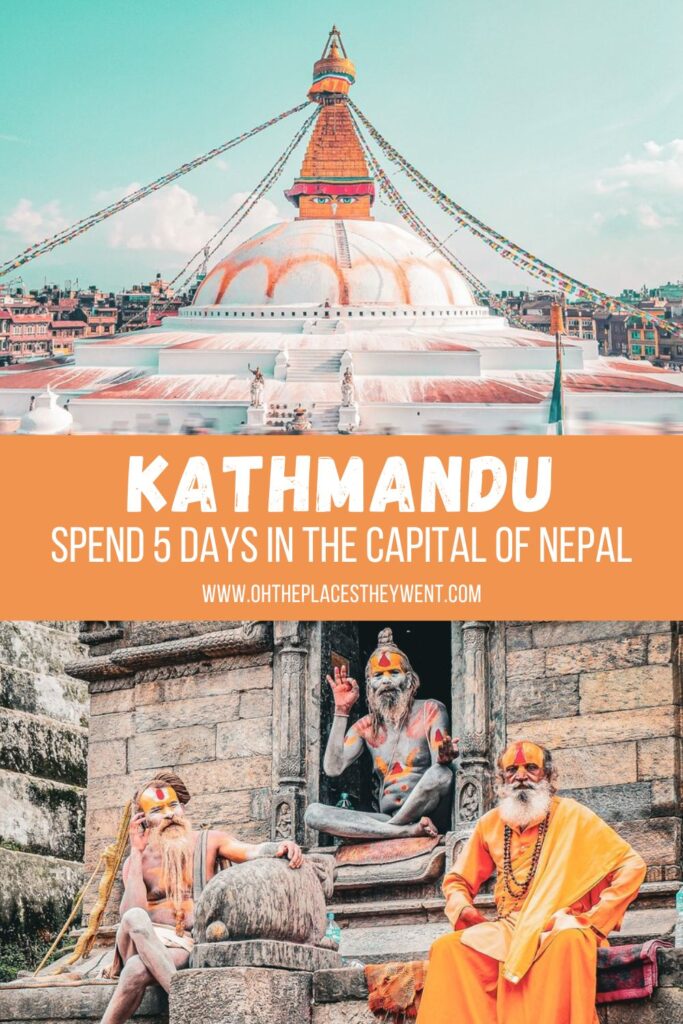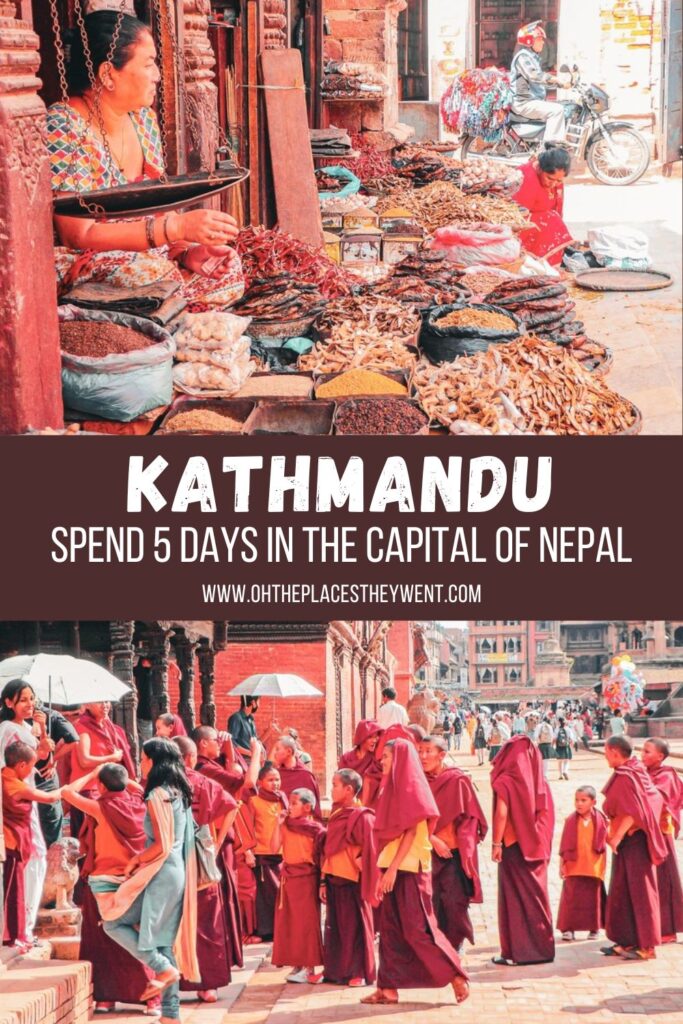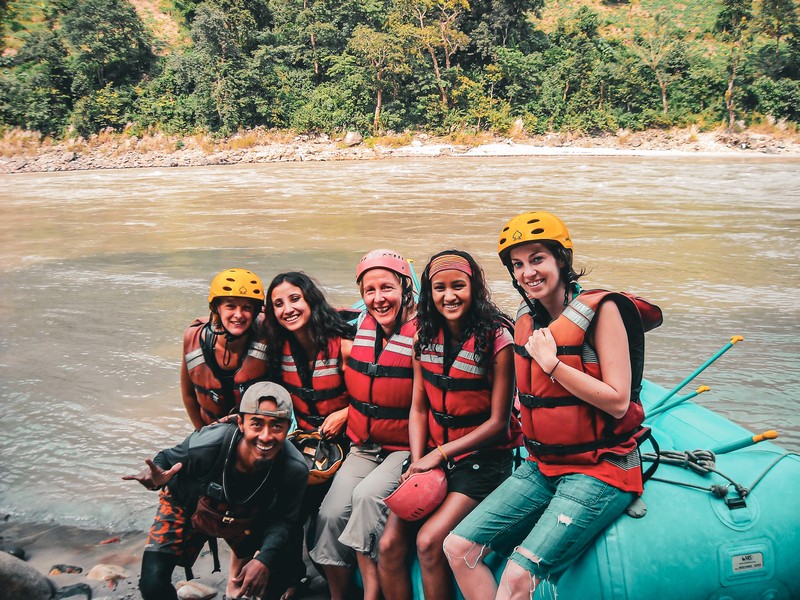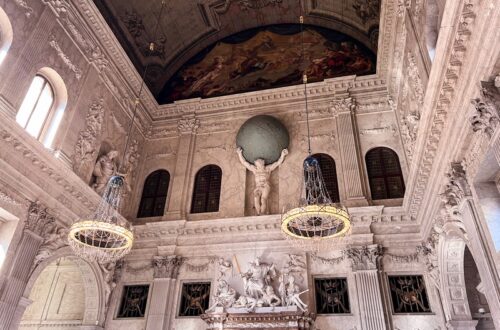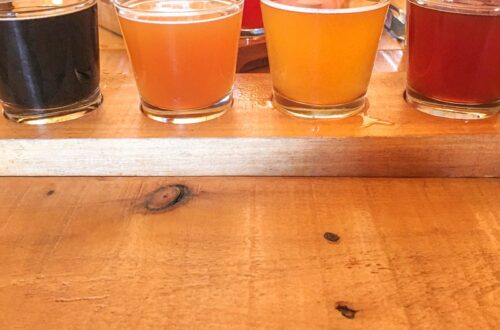What To Do For 5 Days In Kathmandu, Nepal
Nepal is one of those countries that if I had the chance and the time to go again, I would without question. Not every place that I have been gains that distinction, but there was just something about Nepal and the people there. Sandwiched between India and China, Nepal has intrigued me since I was a child for one reason or another and this trip was definitely unforgettable… for a number of reasons.
Whether you’re lured by the adventure to hike the Himalayan Peaks, or to learn about an ancient culture, this is the country that is a must visit and it will blow you away. Spend at least five days in Nepal and you’ll want to go back like me, that’s for sure.
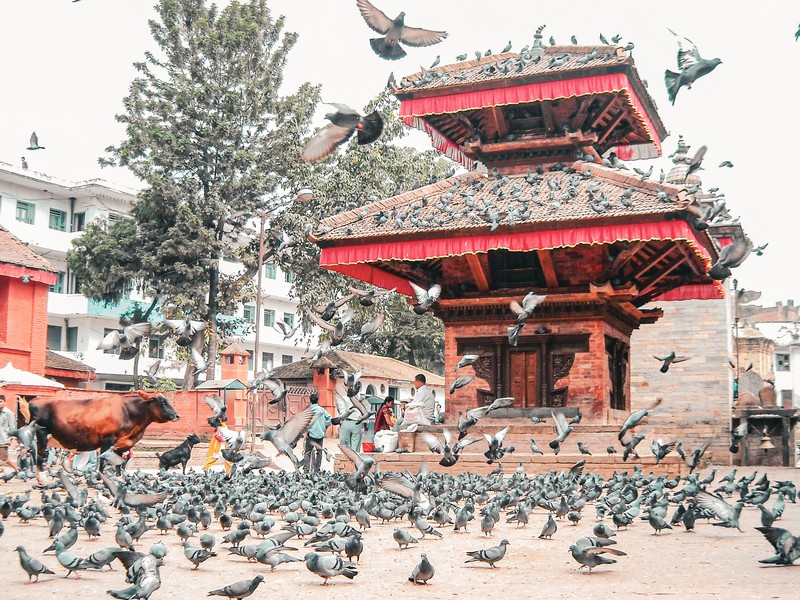
Start your adventure in Kathmandu, Nepal:
- A brief history of Nepal
- What to know about Kathmandu
- Where To Stay
- What To See
- What To Do
- What To Eat
(This page contains affiliate links. That means if you click on them and purchase something, I will get a percentage of the transaction at no cost to you. Thanks for the support!)
A brief history of Nepal
Nepal is a place with a centuries long history and was first mentioned in Vedic texts, a body of religious texts that originated in ancient India. A Sanskrit inscription from 512 BC in the Tistung Valley to the west of Kathmandu says “greetings to the Nepals” and if that isn’t intense, I don’t know what is. A history that long sounds overwhelming but I’m sure that’s also because I’m American and we have such a short history in comparison. The history is extensive so I’ll skip ahead a bit to the most recent important information to know.
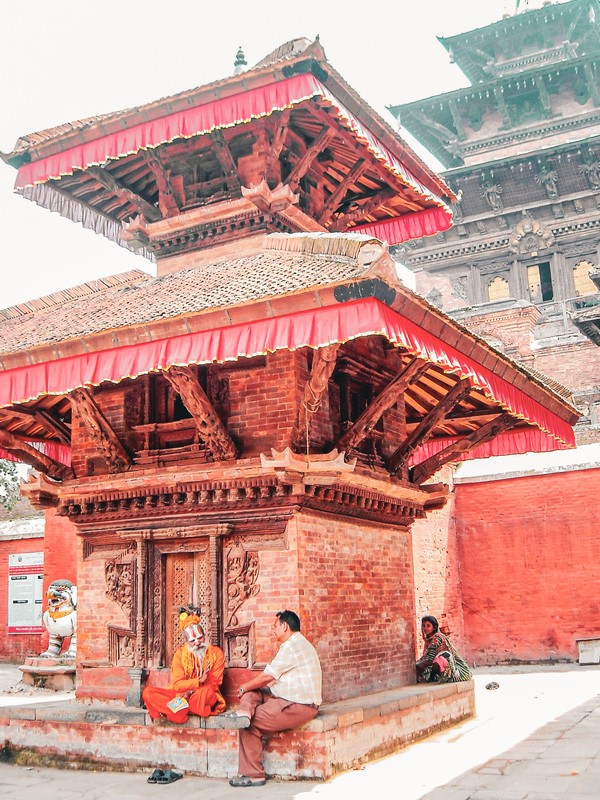
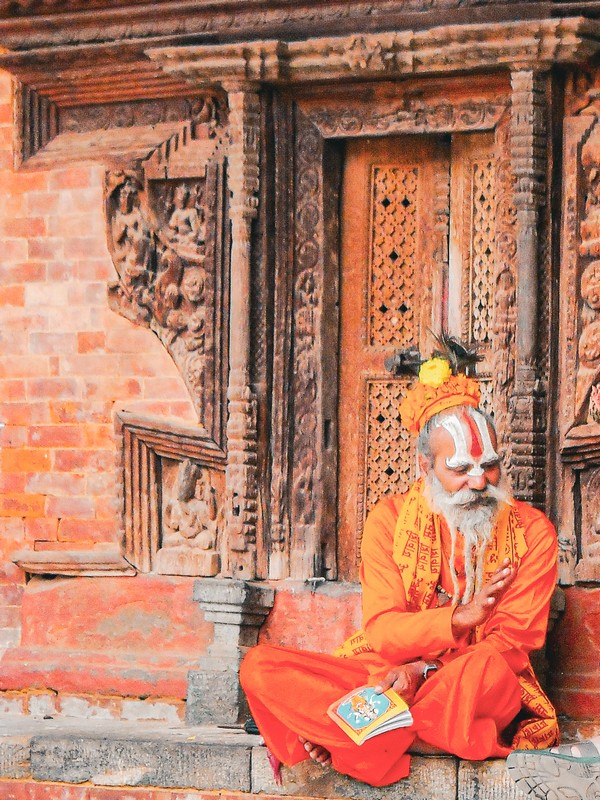
In the mid 18th century, a Ghorka king named Prithvi Narayan Shah set out to put together what is present day Nepal. After battles and various sieges, he managed to conquer the Kathmandu Valley in 1769. Battles and disputes spread which subsequently led to the Qing Emperor of China to begin the Sino-Nepali War. There was also a rivalry happening between the Kingdom of Nepal and the East India Company and led to the Anglo-Nepali War to the south. After various treaties and truces, the wars ended but that didn’t mean complete peace.

If you’re interested in drama within royal families, definitely read more about the factions within the royal family of Nepal. In 1846, the reigning queen had a plan to overthrow Jung Bahadur Kunwar, a rising military leader. The plot was discovered and led to the Kot Massacre in which several hundred princes and chieftains were murdered. Eventually, Jung Bahadur Kunwar came out victorious and founded the Rana Dynasty under which the king was considered a titular figure and the Prime Minister was made a powerful and hereditary position.
Rana’s rule was tyrannical and in the 194os, a pro-democracy movement critical of the Rana autocracy were making noise in the country just as China was invading nearby Tibet. India, looking to counteract the military threat headed their way, asserted more influence in Nepal and sponsored King Tribhuvan as the new ruler which ended the Rana rule. After much scuffling, the democratic experiment in the country was scrapped under King Mahendra who ruled from 1955 to 1972.
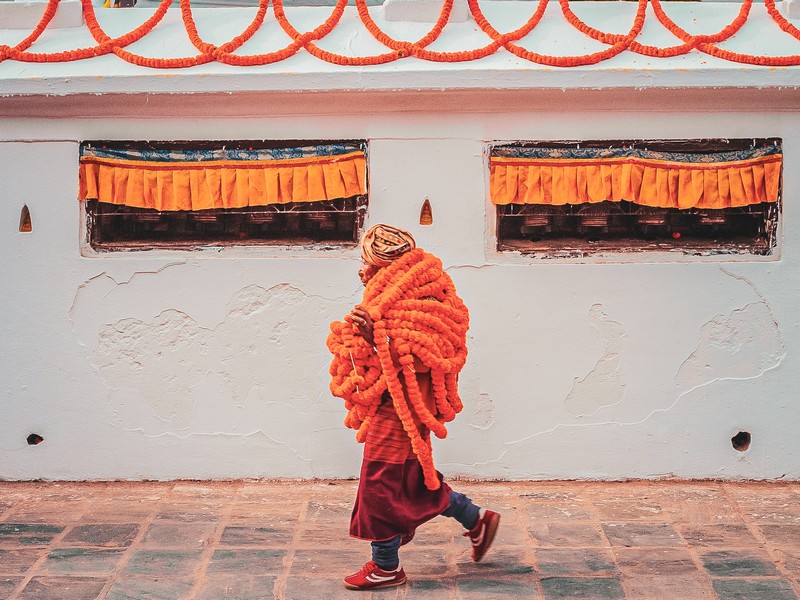
Under King Birendra who ruled from 1972 until 2001, constitutional reforms established a multiparty parliament but in 1996, the Communist Party of Nepal began a bid to replace the royal parliamentary system which led to the Nepali Civil War which accounted for more than 12,000 deaths in the country. That wasn’t the end of the violence.
In 2001, a massacre in the royal palace ended with the deaths of King Birendra, Queen Aishwarya, and seven other members of the royal family. Following the deaths, King Birendra’s brother Gyanendra inherited the throne and in 2005 dismissed his entire government in order to assume full executive powers and quash the Maoist movement takin hold in the country but it was a too little too late situation in 2006 King Gyanendra relinquished the throne to the people.
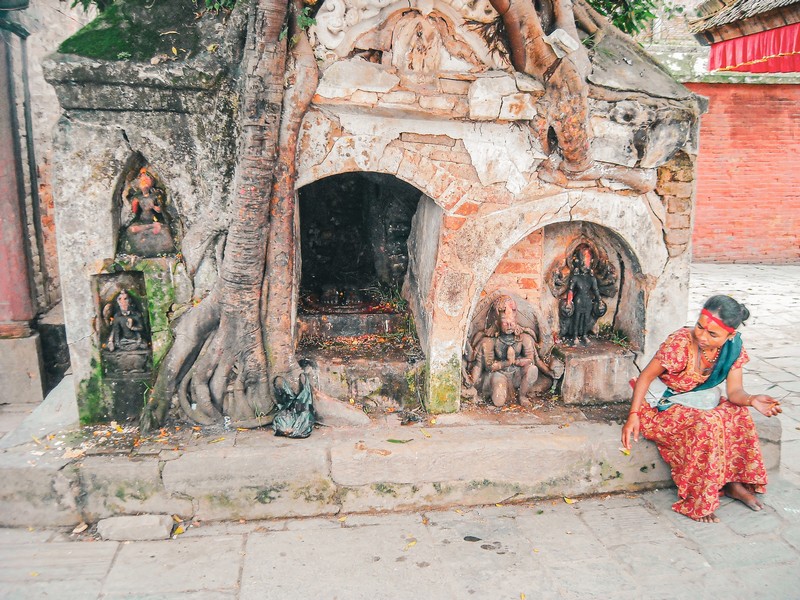
In 2008, the Republic of Nepal was formed under the Unified Communist Party of Nepal and under them, Nepal was declared a secular and inclusive democratic republic and the king was given 15 days to vacate the Narayanhity Palace. Various governments have taken control and been toppled since but today Nepal is a federal democratic republic with seven provinces.
What to know about Kathmandu
Kathmandu, Nepal is a bustling city with so many sights to see and amazing places to be. Most people coming to Nepal will head to Kathmandu, the largest city and capital of Nepal. The historic sites are numerous here and it is easy to get lost in the alleys lined with gorgeous architecture. Backpackers starting in the capital will then usually head out to Pokhara and then maybe on into the Annapurna region or they’ll head to infamous Mt. Everest.
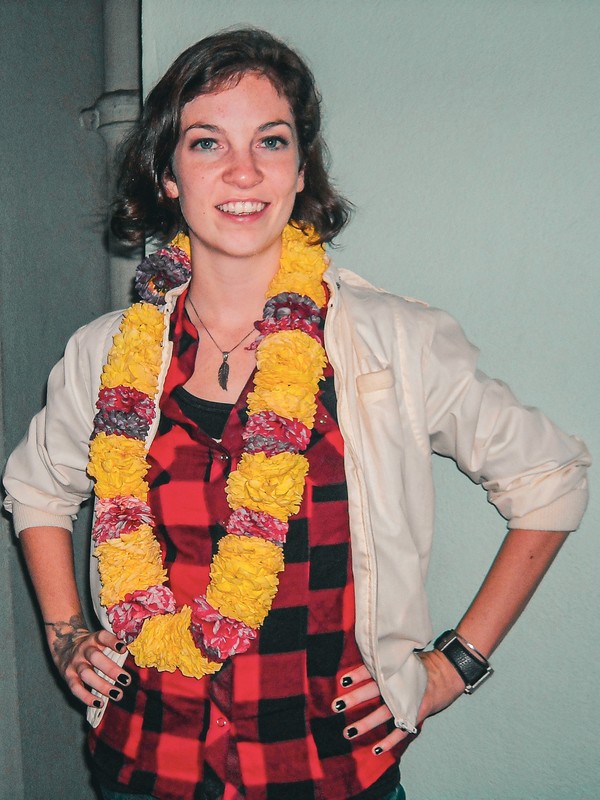
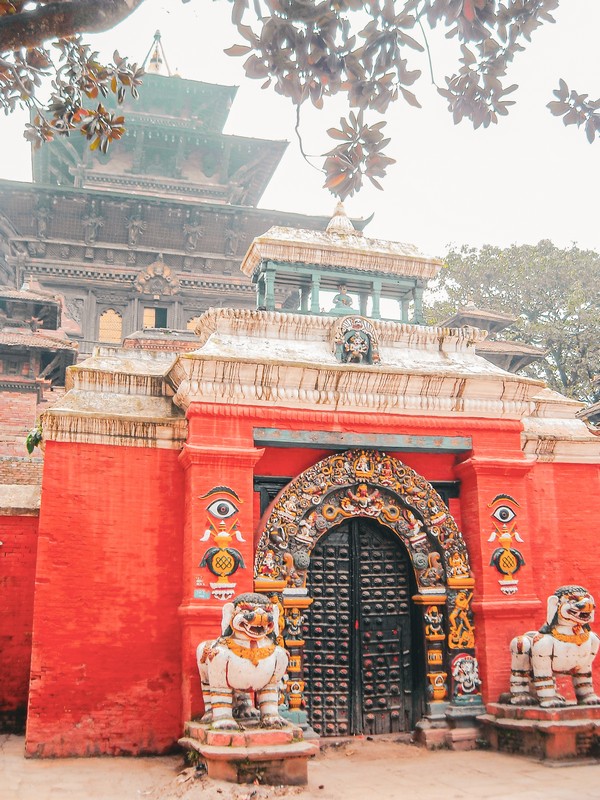
As one of the, or maybe THE, most famous mountains in the world, Everest is one of those places that many people feel the urge to take in when they’re just so so close. While I didn’t have the time to hike it, my travelling partner did and she headed to Nepal about two weeks before I did to hike to Everest Base Camp. The trek takes 12 days and usually begins with a briefing in Kathmandu. While you can definitely just go independently and work your way up, my friend said she was very happy in the end to have a Sherpa and guide with her. The hike is strenuous but you certainly won’t be the only trekker on the mountain. But do get organized.
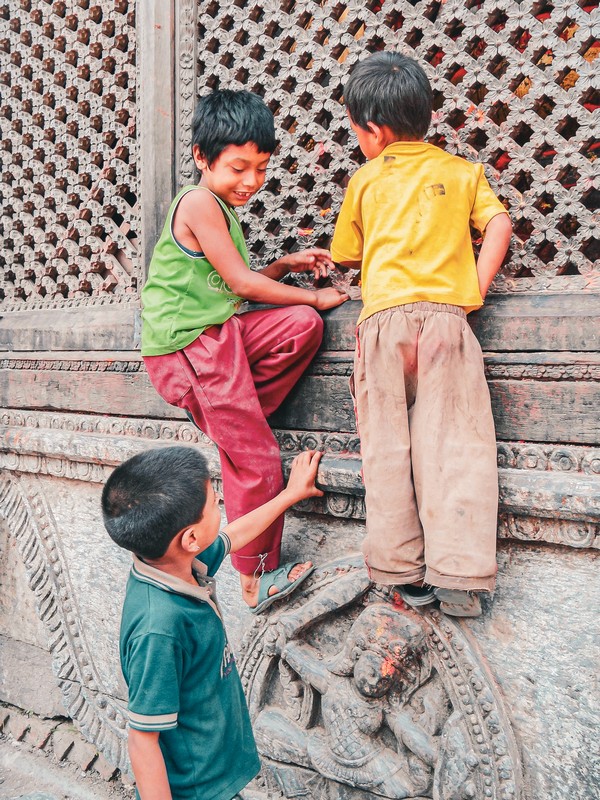
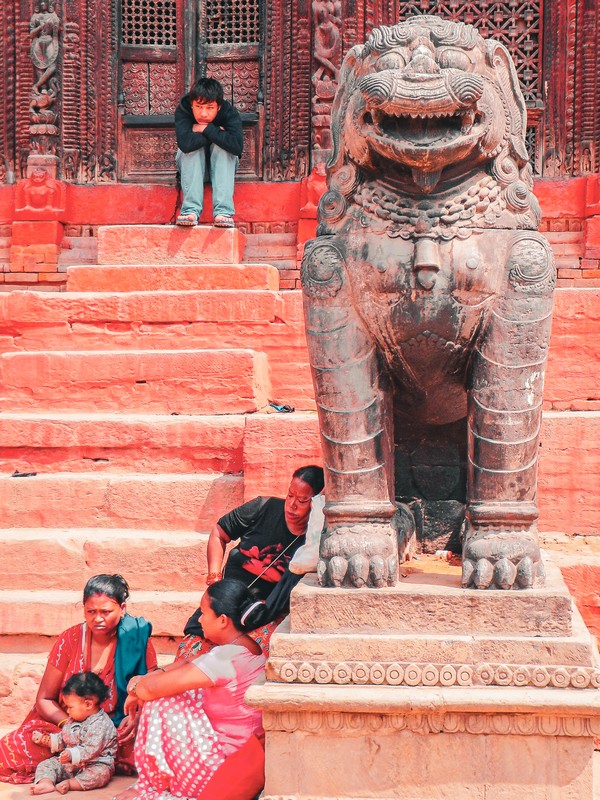
I’m one that would definitely book a tour for something like this if I were doing it and highly recommend checking into the options if this is something you want to do while you’re in Nepal. Usually a booked tour includes a porter to carry your belongings while you’re working your way up, accommodation in the “towns” along the path, and transportation to and from Kathmandu. This would definitely add an unforgettable adventure to any trip to Nepal so do look into it. While I didn’t have the time on this trip, it’s something I’d look into for next time.
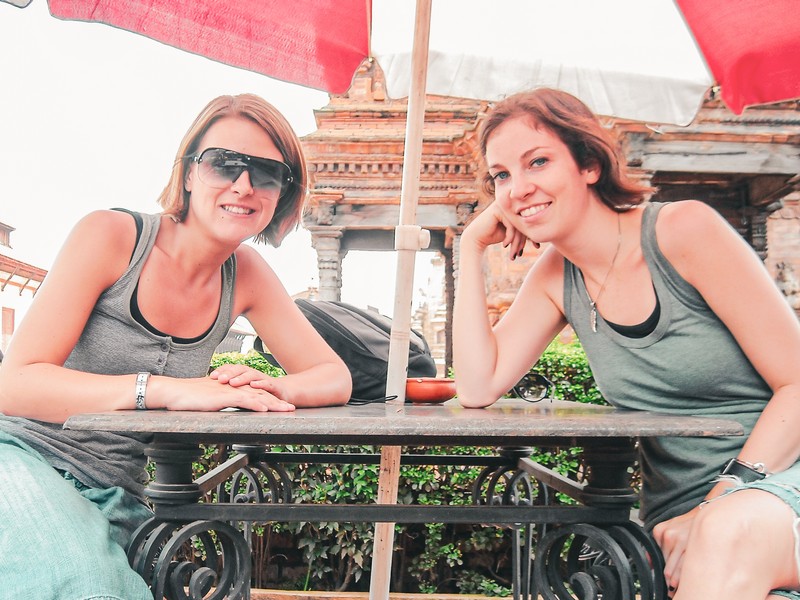
From my travel journal:
Landed in Kathmandu airport last night. Walked off the plane to a bus that took us to a one room airport. They checked us for H1N1, I got my visa and was greeted by Rhiannon [my travel partner] with our hotel owner and a necklace of flowers. Thank goodness they were there because the exit was surrounded with people waving signs and looking to get a visitor into their taxi. It was sensory overload from that first step and I was ready to hit the ground running.
On this hot sunny morning, we ate breakfast with our hotel owner Khem, who speaks English with an Australian accent, before we headed out to see Kathmandu’s Durbar Square, formerly known as Hanuman-khoka Durbar Square.
If your hotel doesn’t offer a transfer, I would definitely hire a service to help you transfer from the airport to your hotel so you don’t have to haggle right after arriving. It can be hectic if you’re not prepared so don’t give yourself stress straight away.
Where To Stay
There are numerous places to stay in the city but most backpackers and travelers to the city will stay in the Thamel area. There are winding alleys and all of the markets and UNESCO sites that are likely in the tourist book you’re toting. There are numerous restaurants and cafes and plenty to do here. If you’re in the city for a short time an like the easy to reach tourist spots, it’s probably the best place to stay but don’t be afraid to stay outside of the Thamel area as well if you want to see more of what the rest of Kathmandu is like with less tourists and just as friendly locals.
The Kantipur Temple House
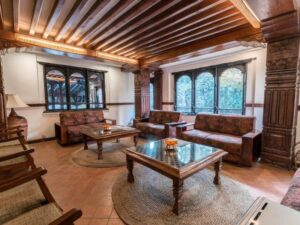
The Kantipur Temple House is an eco-boutique hotel with 48 rooms located in the heart of Kathmandu, walking distance to the tourist hub of Thamel and other cultural highlights like Kathmandu Palace Square and Swayambhunath Buddhist stupa. The hotel is built in the age-old architecture of the Kathmandu Valley and has taken care to portray the rich cultural heritage in each room and restaurant. Everything is locally made, providing a rich ambience. The hotel has all the comforts and conveniences of home and provides a perfect and cultural space to stay in the bustling city.
Book a room at The Kantipur Temple House on Booking.com or on Agoda.com.
The Dwarika’s Resort
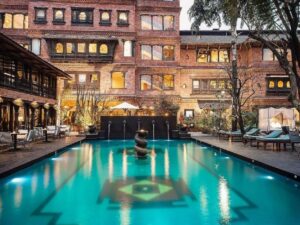
Whether you’re a tourist or traveling on business, The Dwarika’s Resort is a great choice for accommodation when visiting Kathmandu. This is luxury for travelers and is a collection of formerly traditional Nepali homes that have been converted. Get the feeling of stepping back in time while staying here. From here, guests can enjoy easy access to all that the lively city has to offer. Also within easy reach are Dhulikhel Hospital. The Dwarika’s Resort also offers many facilities to enrich your stay in Kathmandu.
Book a room at The Dwarika’s Resort on Booking.com or on Agoda.com.
What To See
As mentioned above, Kathmandu is a collection of alleys and winding roads filled with people and markets and beautiful things to see. To get yourself sorted when you first get there, I recommend getting a guide to get the most from the meandering. Once you’ve got yourself sorted, you can definitely visit some places on your own.
Tours I’d recommend for Kathmandu, Nepal:
- Kathmandu Full Day Exploration: Visit Kathmandu’s Durbar Square, Swayambhunath Stupa, Boudhanath Stupa, and Pashupatinath. You can book this tour on Klook or on Get Your Guide.
- Patan and Bhaktapur Tour: Just outside of Kathmandu, Patan and Bhaktapur are two ancient cities that are considered the finest collection of temples and palaces in Nepal. Join a tour to visit them on Klook or on Get Your Guide.
Kathmandu Durbar Square
This square is one of three Durbar (royal palace) Squares in Kathmandu. A bit back in history there were three main kingdoms: Basantapur (Kathmandu), Bhaktapur, and Patan and each had a royal palace surrounding these sqquares. The buildings in this square were built from the time of King Ratna Malla, 1484AD to 1520AD, to King Prithi Bir Bikram Shah, 1881AD – 1911AD.
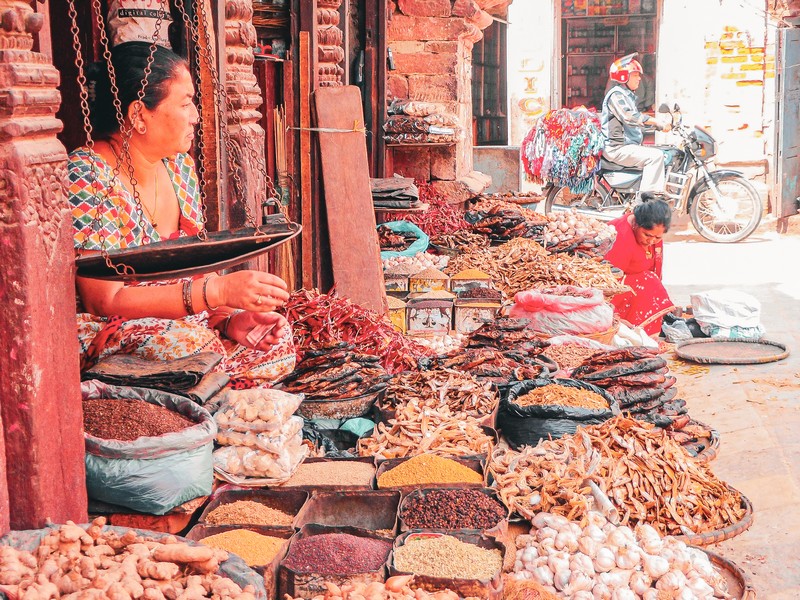
Kathmandu’s Durbar Square was used as the royal Nepalese residences up until the 19th century and though the royal family no longer resides there, it is still used for coronations and other royal ceremonies. There are temples, statues, open courtyards and fountains to roam around and take in. This is the largest of the royal palace complexes from the medieval period in Nepal.
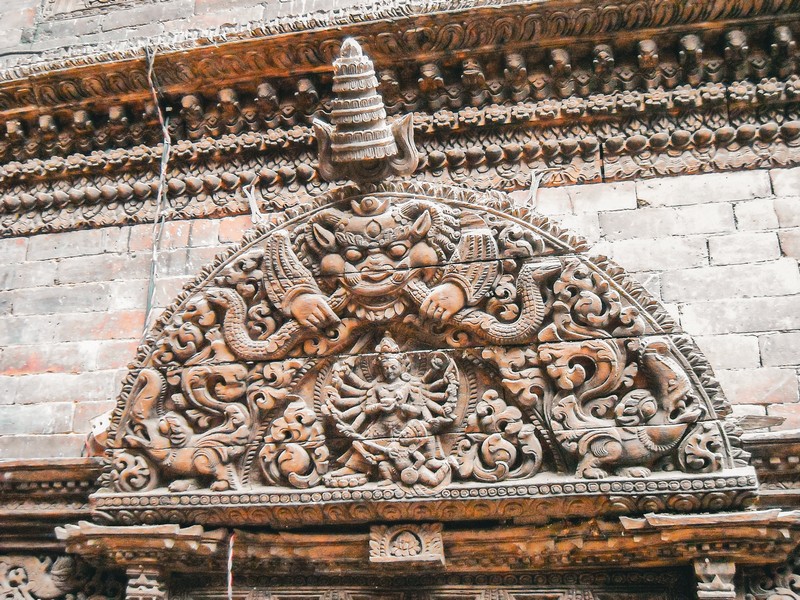
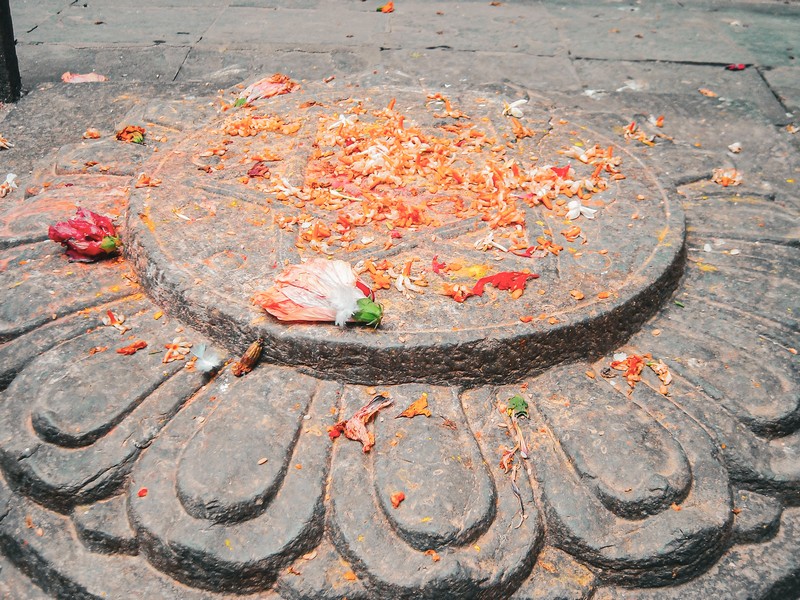
Unfortunately, several of the buildings in this square collapsed due to the earthquake that shook the city, but the majority of buildings were fine. I highly recommend getting a guide to learn more about the area as you walk the area. There is so much to see and so much to learn and a guide will let you know which buildings and shrines you can walk on and climb up.
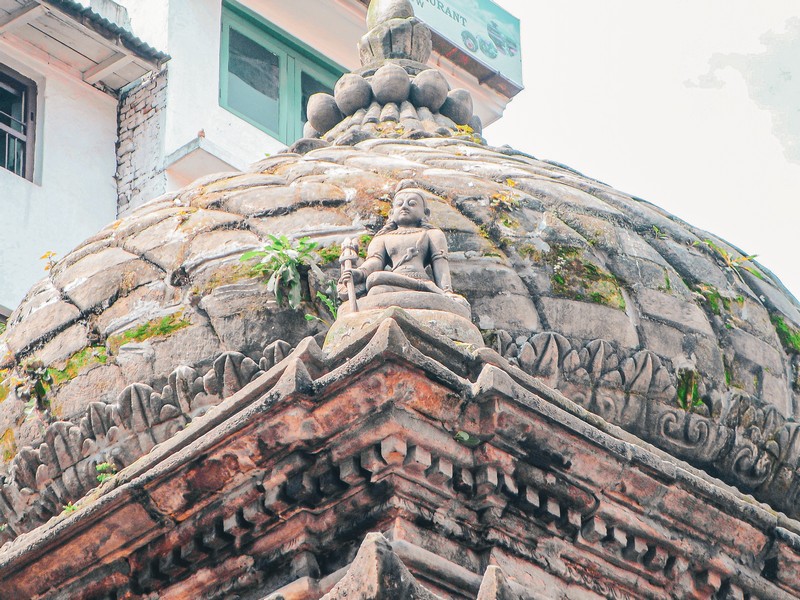
From my travel journal:
We met a man who offered to be our guide and I eagerly accepted to learn something about this busy fun area. First, we saw Kumari Bahal, a traditional 18th century Newari palace built by King Jaya Prakesh Malla. It was small when compared with what I pictured as a “palace” in my mind. It houses the living, earthly human goddess Kumari who was just chosen last year. She came to the window and looked down on us, we waved but she showed no reaction… she is only four.
Kumari is chosen at the age of four or five from the Newari Shakya, or goldsmith, caste. She must meet 32 requirements such as having thighs like a deer, a chest like a lion, eye lashes like a cow and a body like a banyan tree. She must remain calm in a dark room filled with buffalo heads, frightening masks and loud noises. She must also have an astrological chart that does not conflict with the King’s. After these things are met, she is placed in this palace until she reaches puberty. Her feet must never touch the ground. Once she begins to menstruate or shed blood in any way, her goddess spirit leaves her body and she is placed in her parents’ home where the transition is usually difficult going back to mere mortality.
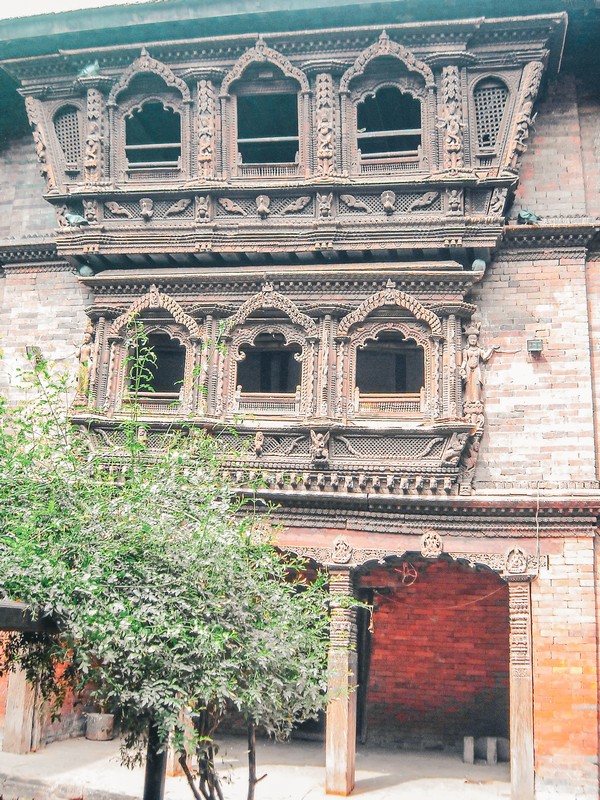
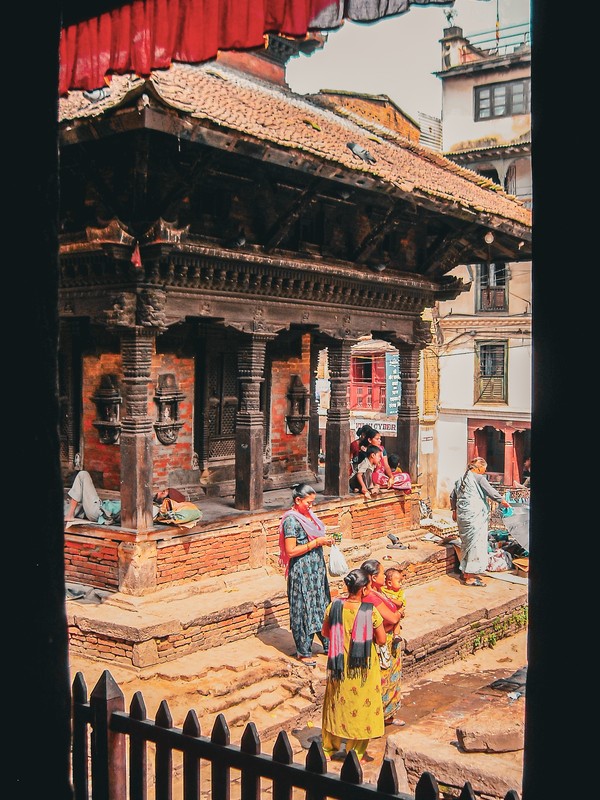
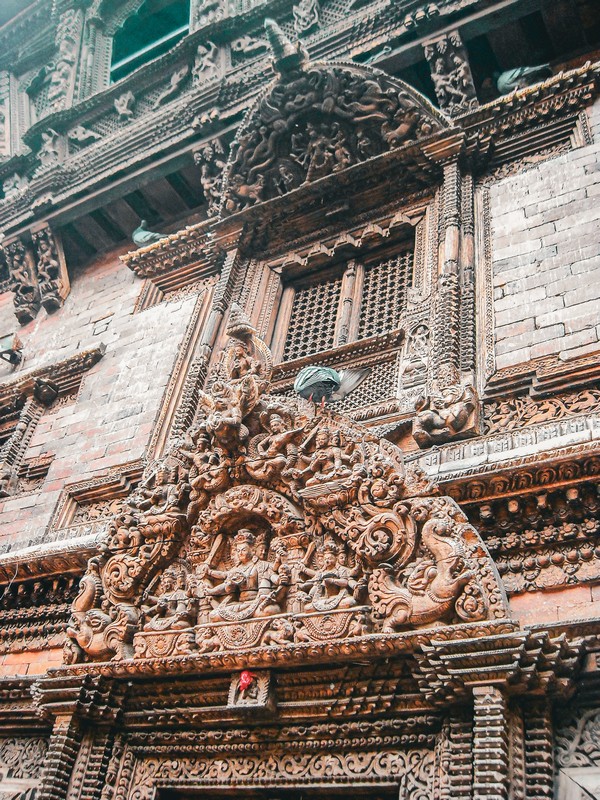
The area was bustling with Nepalis selling everything from linens and flowers to seeds and necklaces. There were cows that were roaming or sleeping in the shade having been released by their owners when they stopped giving milk and they are now fed by the helpful hands of those in the vicinity. There were so many temples each dedicated to a different God or Goddess in this vibrantly colored town center.
It was a lot to take in on our first adventure out but we were so excited to see more. It was difficult keeping all of the Gods and Goddesses straight but it became more intriguing listening to our guide explain why the Nepalis people worship each one and what they each represented…

Swayambhunath (Monkey Temple)
Swayambhunath is also known as Monkey Temple due to the holy monkeys that reside in the forests of the “Sublime Trees” as the name of the area is known in Tibetan. As one of the oldest religious sites in the country, this is an essential stop on any visit to Kathmandu.
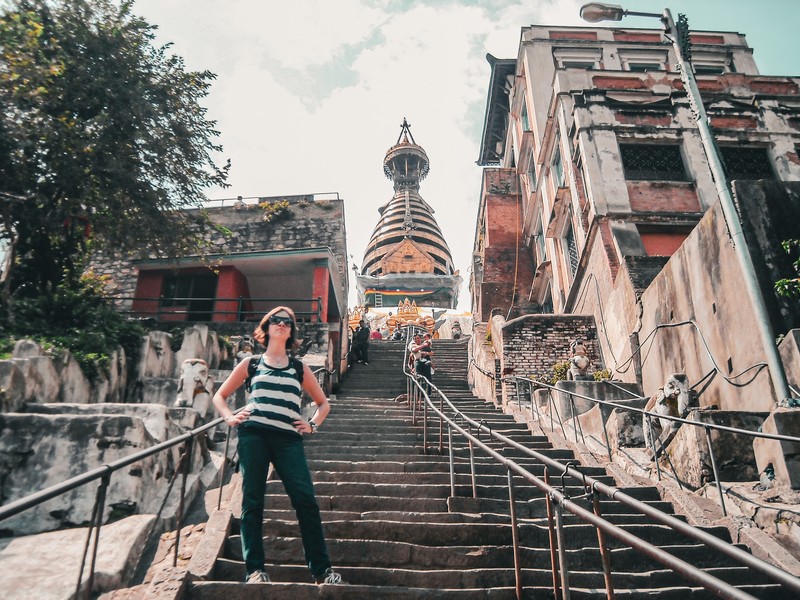
According to an inscription on a stone found there, Swayambhunath was founded at the beginning of the 5th century CE. Eyes of the Buddha are painted on the stupa looking in all four directions representing wisdom and compassion and above each pair of eyes is the third eye. It is said that when the Buddha preaches, rays emanate from the third eye sending messages to the heavenly beings and relieving the stresses of those suffering. The stupa is also important for Tibetan Buddhists though it comes in second to Boudhanath which we saw a bit later in our trip.
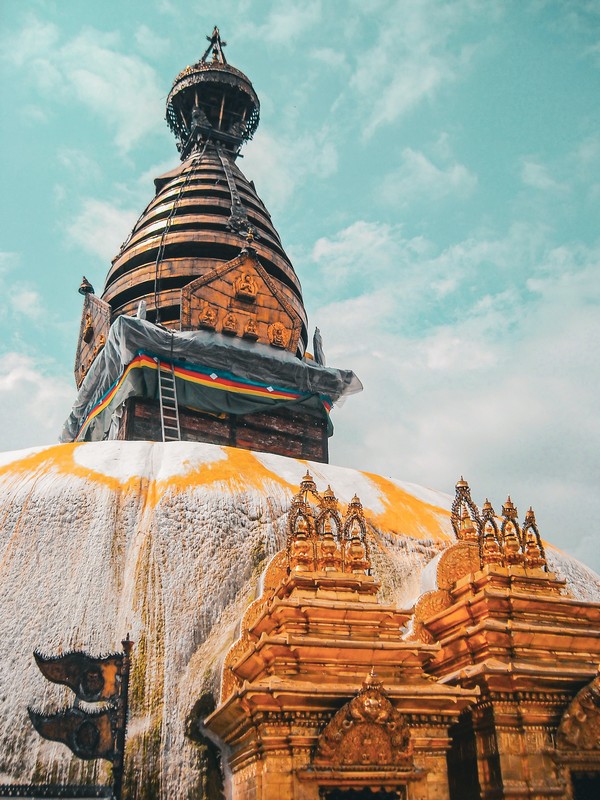
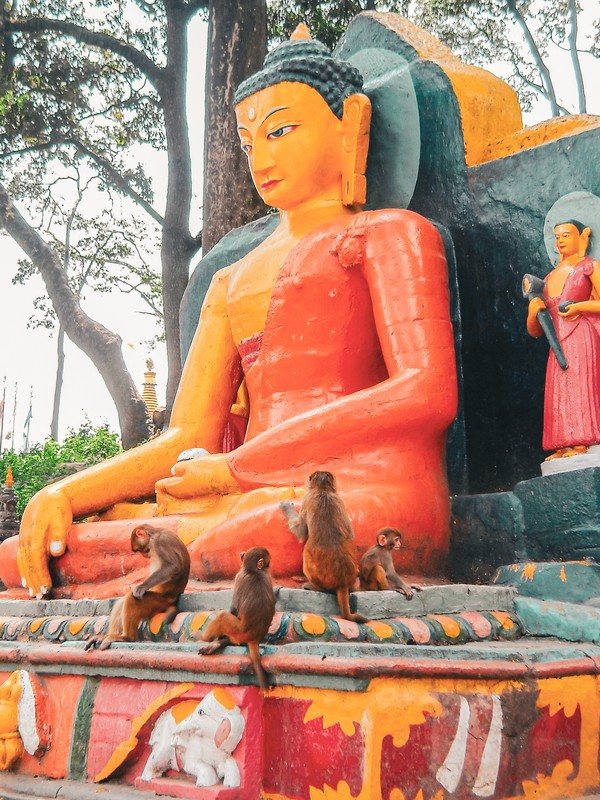
Walk up 365 steps while monkeys clamor all around the path and statues leading up to the stupa. They chatter and seemingly play tag. The white dome of the stupa represents the creative womb and the 13 discs represent the steps to Nirvana. This was a spot that spoke to me in so many ways and I highly recommend stopping to find a good seat to take it all in when you’re there.
Garden of Dreams
Unlike everything else you’ll probably see on your trip to Kathmandu, this gem was built in the 1920s and features a neo-classical European inspired garden. Spend time here to rejuvenate in a quiet space that is really hard to come by in the rest of the city. There are ponds filled with lilies and lush trees and is found just south of Thamel along Tridevi Marg.

Boudhanath Stupa
From my travel journal:
…Caught another bus though this one ended up being more of a mini-van with a motorbike motor. We got to where we wanted to go though it was a bit confusing when the drivers didn’t know what we were saying and we didn’t know what they were saying.
Boudhanath is the largest stupa in Nepal [and the holiest Tibetan temple outside of Tibet]. They don’t know who laid the original foundation but the story is that Jyajima, a poor girl from a small village, gave birth to four sons by four different men (interesting that they add that aside at the end). She gained much wealth by her sons and decided to build a stupa. She died four years into the construction, but her sons completed the first level.
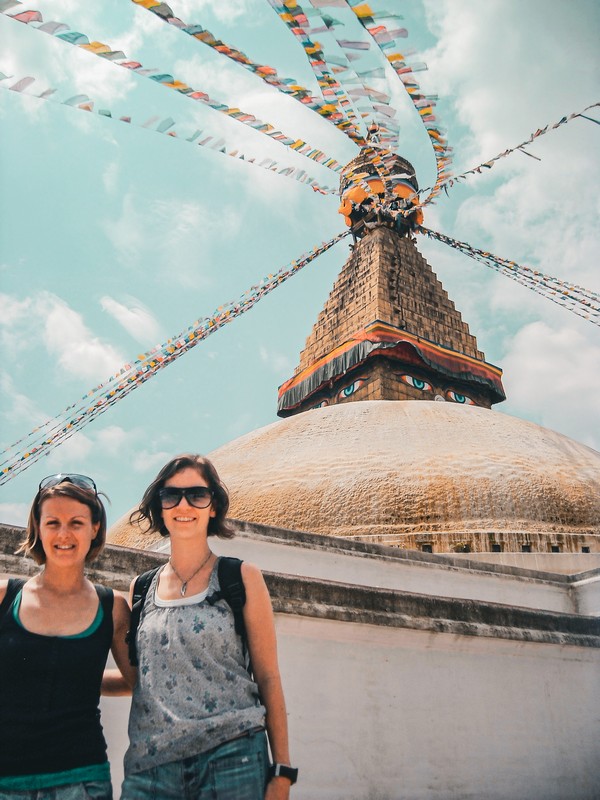
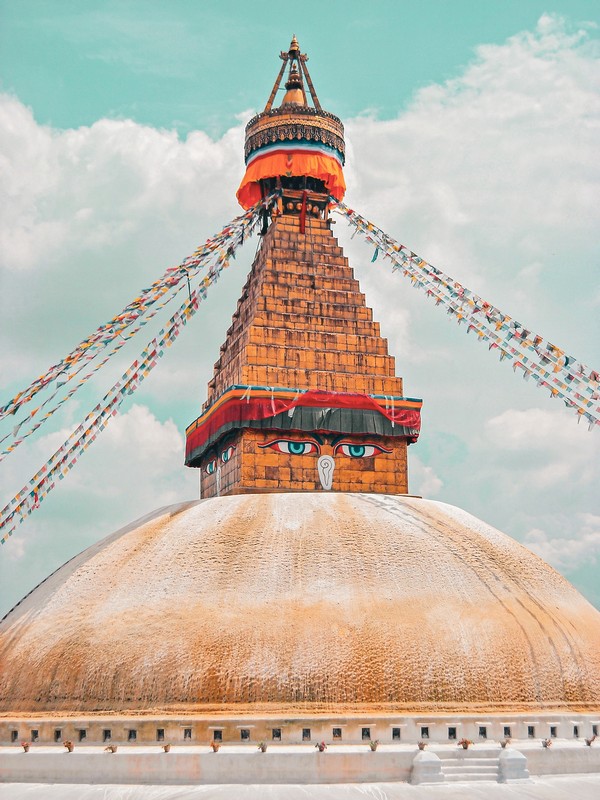
Another version of the story adds that she was married to each of the men she had a son with. One was a horse trader, one a pig trader, one a dog trader and one a poultry business man. Construction of the stupa ended up taking seven years and started with just soil, bricks and stones that were carried to the location atop elephants, horses and donkeys.
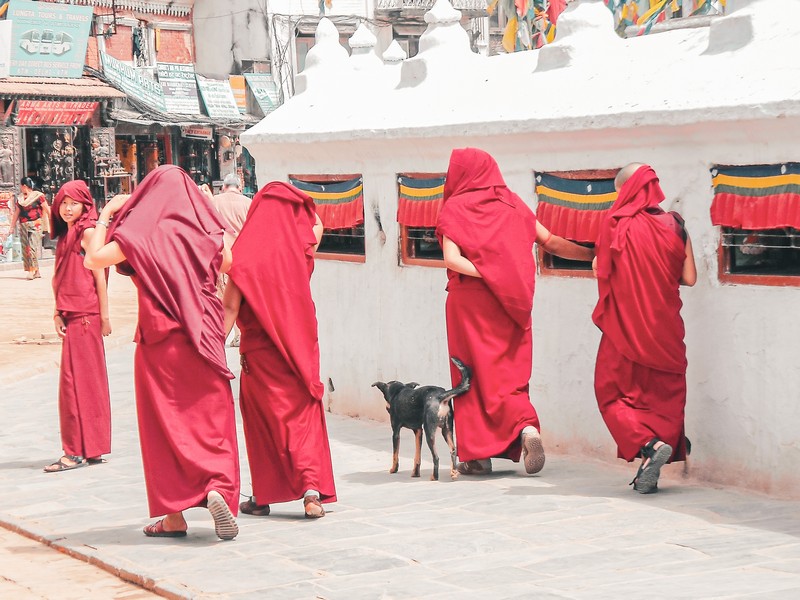
After the stupa was completed, each son prayed. Tajibu prayed to be king and became Dharma King Trisong Detsen in Tibet in his next life. Phagjibu prayed to be a scholar and became Bodhisattva Santaraksita, a teacher in Tibet in his next life. Khyijibu became a guru in his next life and suppressed demons and protected the religion and finally Jyajibu prayed to be a minister and became one in his next life. However, though the sons prayed for themselves, they did not pray for the animals that transported the materials to make the stupa and so the animals became angry. The animals prayed as well and became demons always at odds with the sons in their next lives.
Pashupatinath Temple
Dedicated to Lord Shiva, this temple is one of the four most important religious sites in Asia devoted to Shiva. It was built in the 5th century and is the largest temple complex in Nepal. Only Hindus are allowed to enter inside the gates of the main temple, but if you’re not Hindu, you can still walk the grounds around the rest of the complex. Pashupatinath is one of eight UNESCO Cultural Heritage Sites in the Kathmandu Valley and I’d recommend a visit though it’s definitely not for the faint hearted.
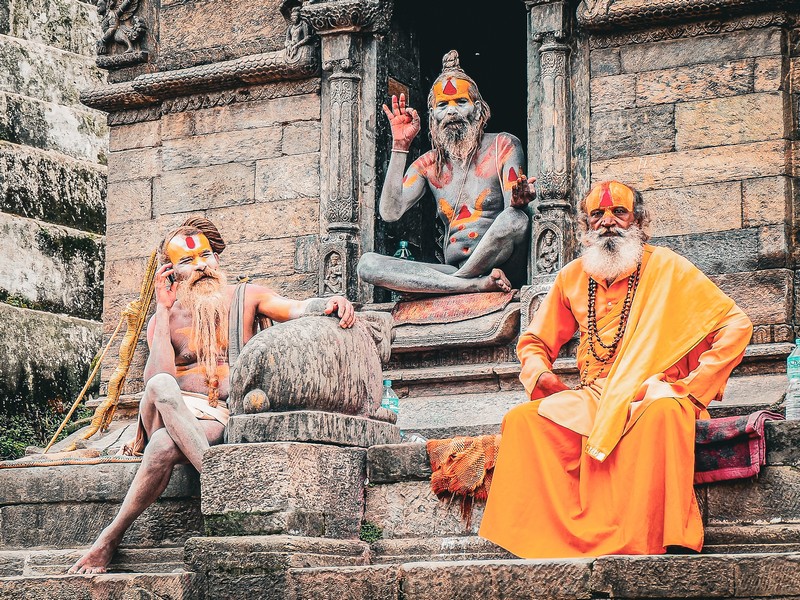
If you’re not Hindu, you’ll basically be sent up and around to an overlook which gives you a view of the cremation Ghats. Remember to be respectful here. We didn’t have a guide and didn’t realize what we were watching so took a couple of pictures but as soon as I realized what I was looking at, I lowered my camera and respectfully witnessed the ceremony before me. I recommend you do the same.
After taking in Bouddhanath, we decided to walk to Pashupati. We walked through fields and the day ended up being much hotter than we expected. Pashupati is one of the holiest temples in the world, worshiped by Hindus and Buddhists.
We couldn’t enter as we’re not worshippers and instead we were ushered to an overlook where we could see the cremations taking place… though it took us a bit to realize that’s what we were watching. Once we figured out what we were watching, it was rather awkward as it is such a holy event and a personal one.
Cremations take place here 24 hours a day. A wooden stand is built with hay and the body is laid on top wrapped in cloth. Wreaths of flowers are put atop and then the whole thing is set on fire with the family watching. We could see the shape of the heads and feet and after a few minutes we decided it was time for us to depart back to our hotel for dinner.
Bhaktapur
Another one of the three the Durbar Squares, or palace squares, of the Kathmandu Valley, Bhaktapur is generally described as the most well-preserved. While you may think once you’ve seen one, you’ve seen them all. You’d be wrong. Each Durbar Square definitely has a feeling all its own.
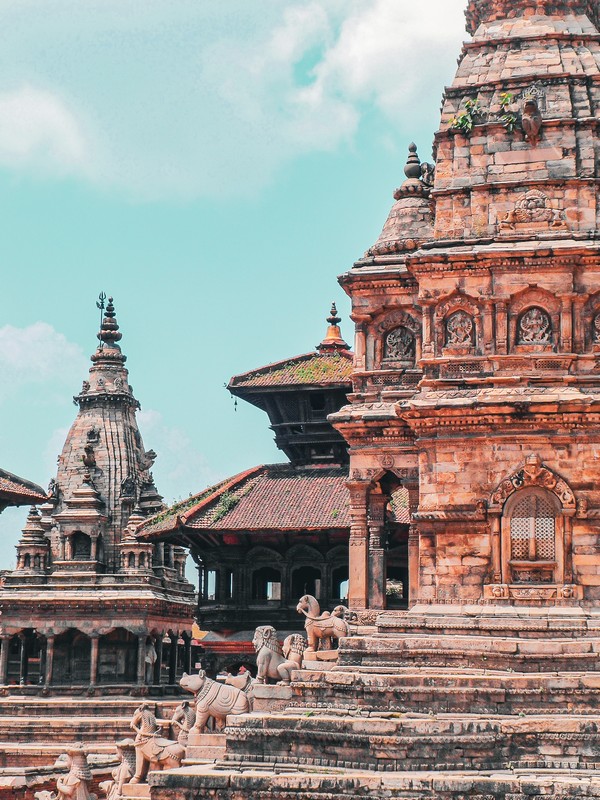
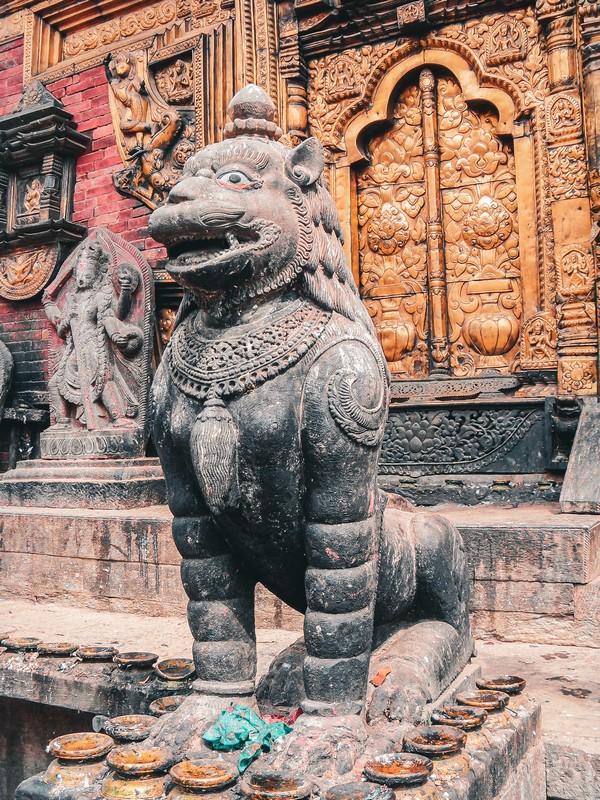
Bhaktapur was founded in the 12th century by King Ananda Malla and was the capital city of the Malla Kingdom until the 15th century. We made our way around and saw what we saw, but I would have loved to have a guide here. My friend was working under quite the budget constraints having just spent quite a bit on her hike to Everest. But, if you can, get a guide.
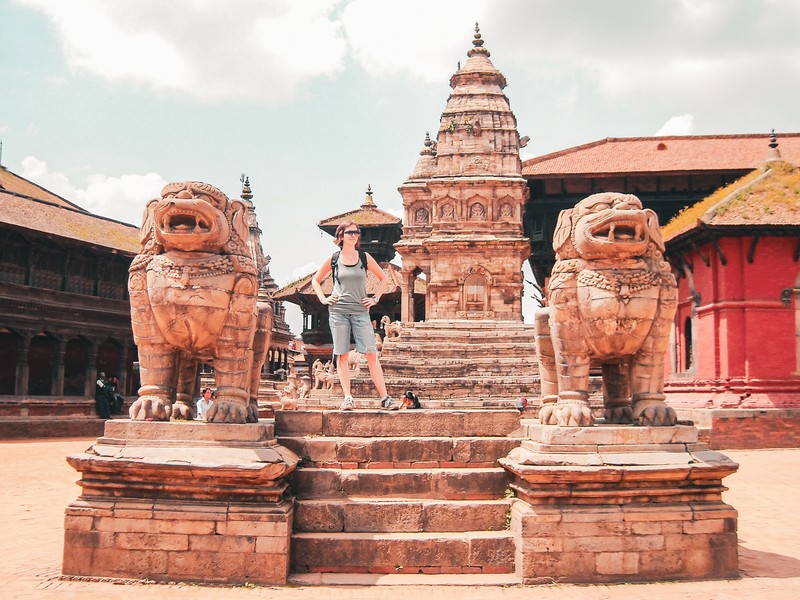
From my travel journal:
We braved the buses, which we’d heard from a fellow backpacker was going to be a treat in itself. It took us some time just to find the stop since there were no [obvious] signs and we were going in circles asking shop owners where it was [we should be standing]. Finally, we realized there were buses randomly stopping with a kid yelling out the side. We would just have to jump aboard and hope we got there since we were never quite sure what they were saying. Luckily, there was a British teacher aboard who told us the actual cost was Rs15 though they often find the foreigners and will charge Rs50. We ended up paying the lower price with her.
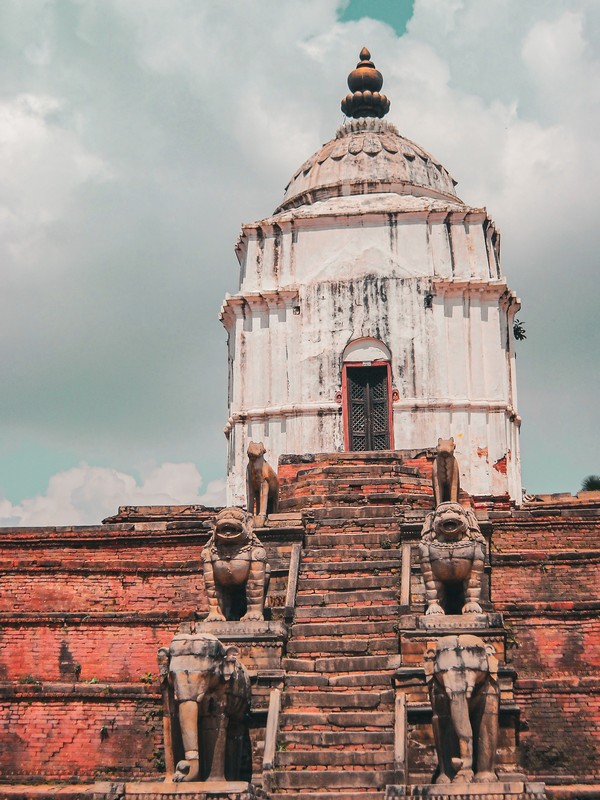
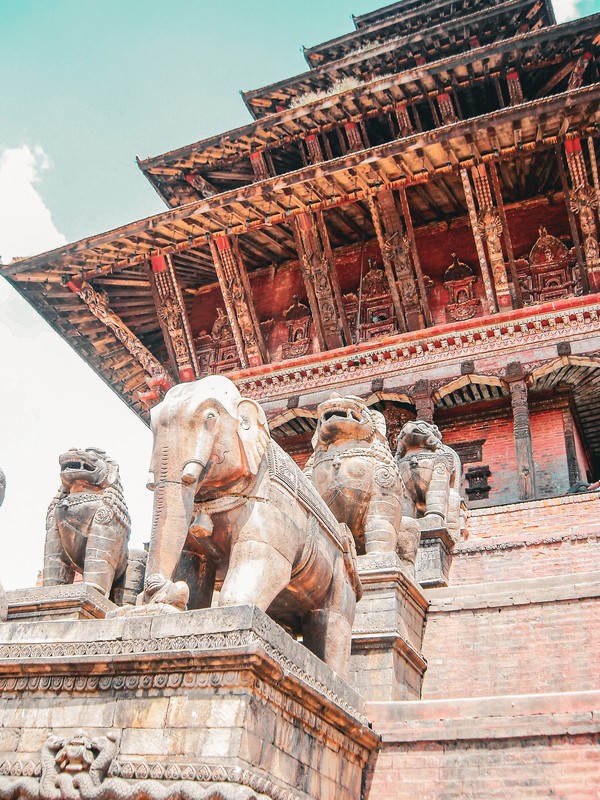
Bhaktapur went through a huge earthquake in 1934 [which destroyed over 2,000 homes and damaged another 2,000]. Because of that they restored the city to its 15th century splendor during the rebuild. They don’t allow cars so it is a very pleasant place to walk around. We took our time, drank some chai tea at a cafe and enjoyed the town.
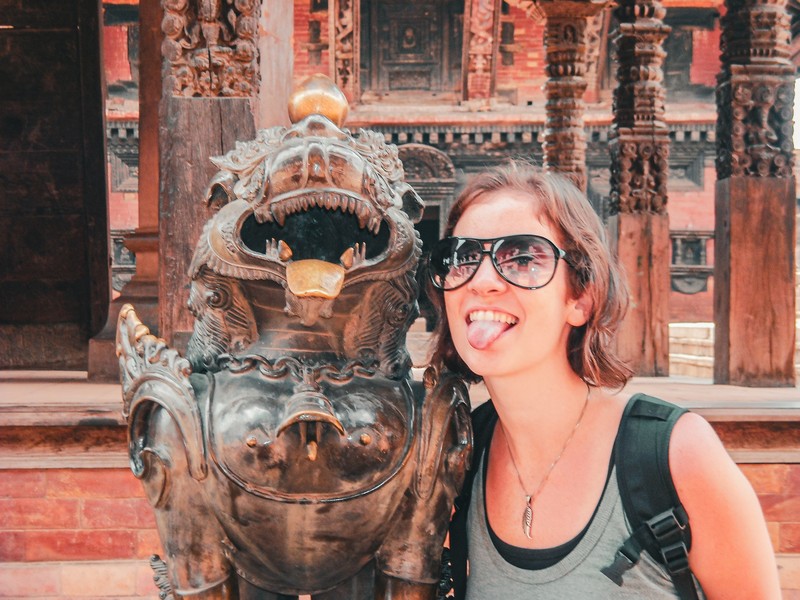
A site that stands out and rises above the rest is Nyatapola Temple a 5 story pagoda erected by Nepali King Bhupatindra Malla in 1702. It is devoted to Siddha Laxmi, the Hindu goddess of prosperity. The whole area is filled with both Hindu and Buddhist religious sites and without all of the cars and motor vehicles going this way and that, it had a completely different vibe from Kathmandu’s Durbar Square.
Changu Narayan
Changu Narayan is the oldest temple in Nepal and is said to be the oldest Hindu temple still in use in the Kathmandu Valley. It was first built in the 4th century and has been expanded upon over the years to show artistic work over the centuries. The sculptures and pieces depicting Vishnu were amazing and intricate.
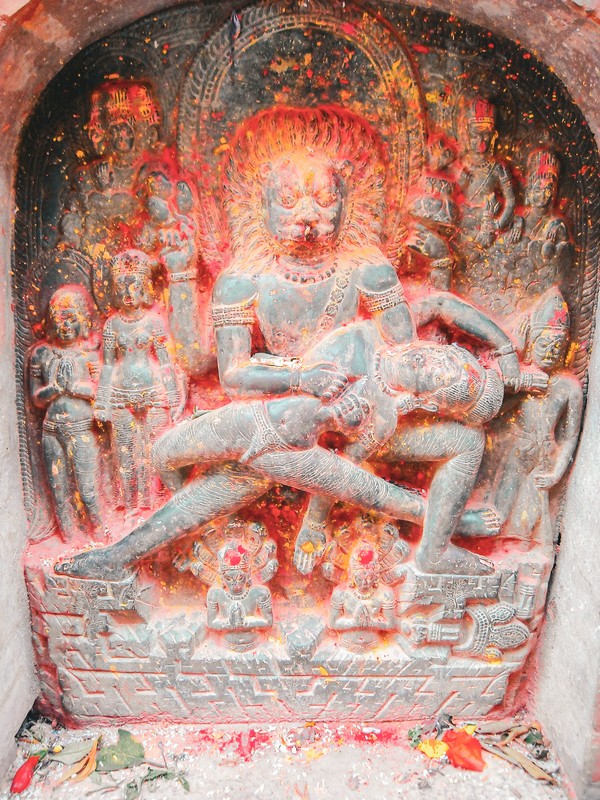
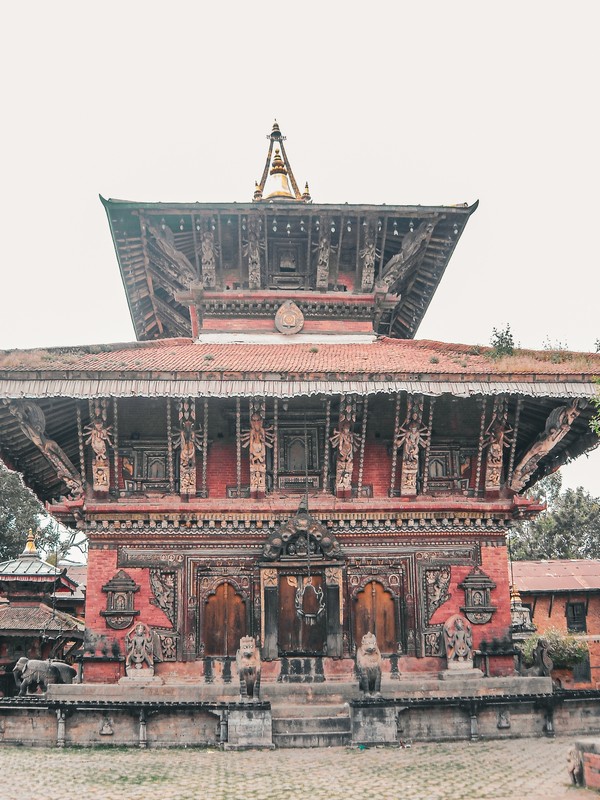
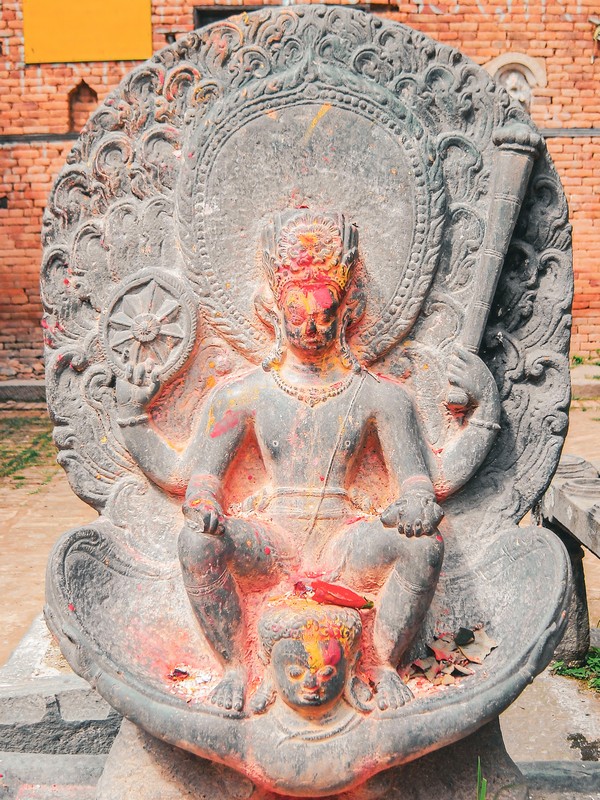
Changu Narayan is an ancient Hindu temple and is 6 kilometers to the north of Bhaktapur. Dedicated to Vishnu, there is a two-tiered pagoda-style shrine in the center surrounded by mythical beasts including ram-horned griffons and winged lions. We were the only visitors when we stopped in to the temple so though it’s historically important, it seems to be off the beaten path just enough.
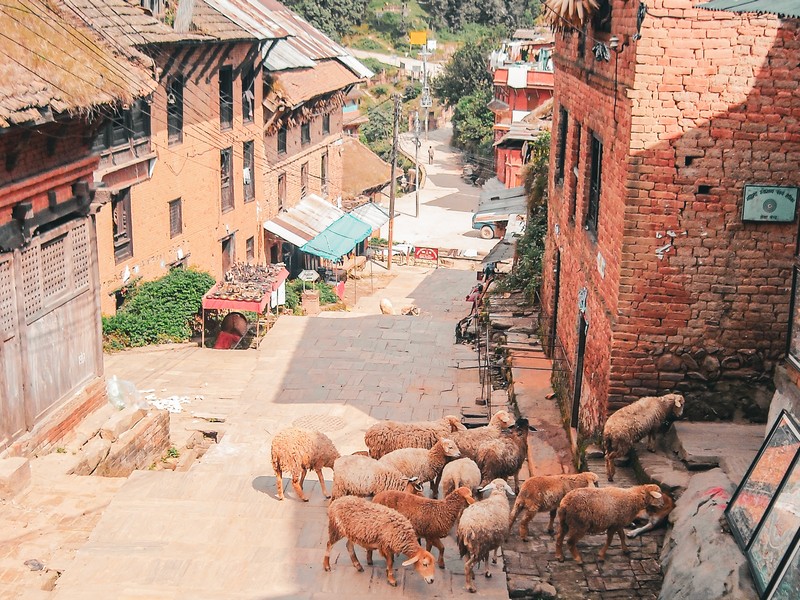
From my travel journal:
After chai in Bhaktapur we decided to get a bus up to Changu Narayan. The bus wove up and around a mountain on a narrow street. The bus had to back up a few times and work around other buses, too. Riding on top is a normal thing here, though we’re not ready for that just yet.
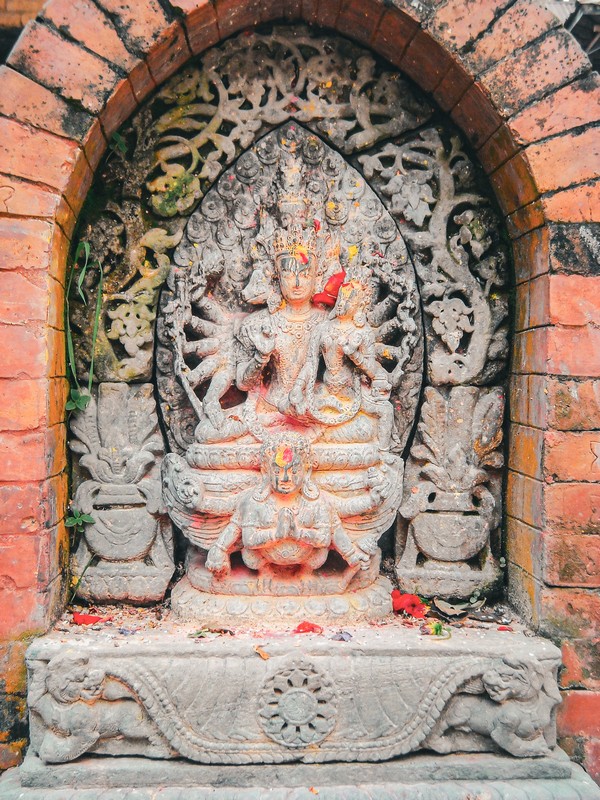
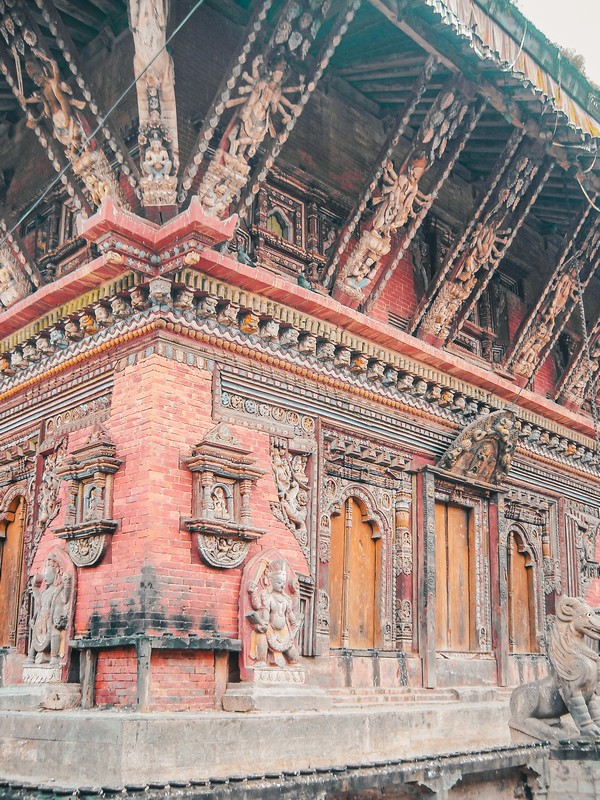
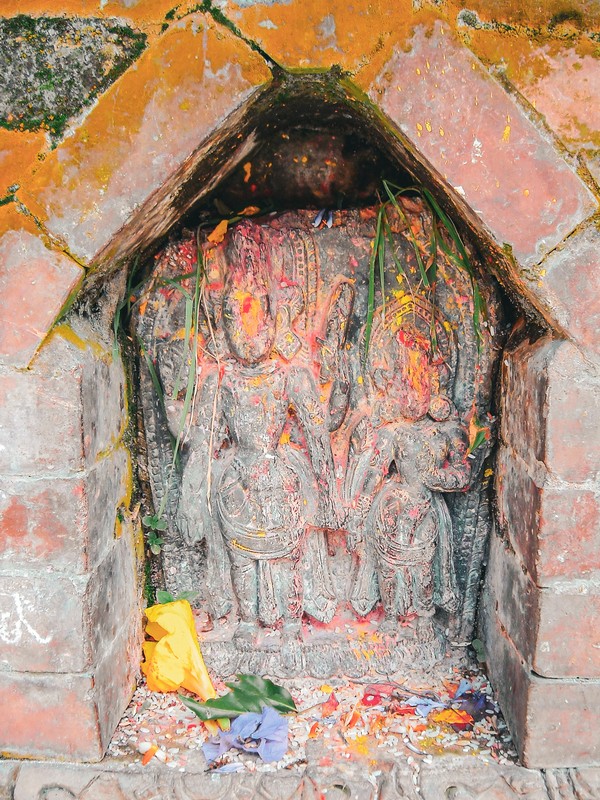
After walking around the temple and back down the one street from the temple to the bus stop, we stopped and watched as an old women dried corn and a herd of goats made their way down the road we all shared. The group on the bus was interesting: farmers with a load of crops to be taken down filled the aisle, school children returning home and women gossiping in their seats.
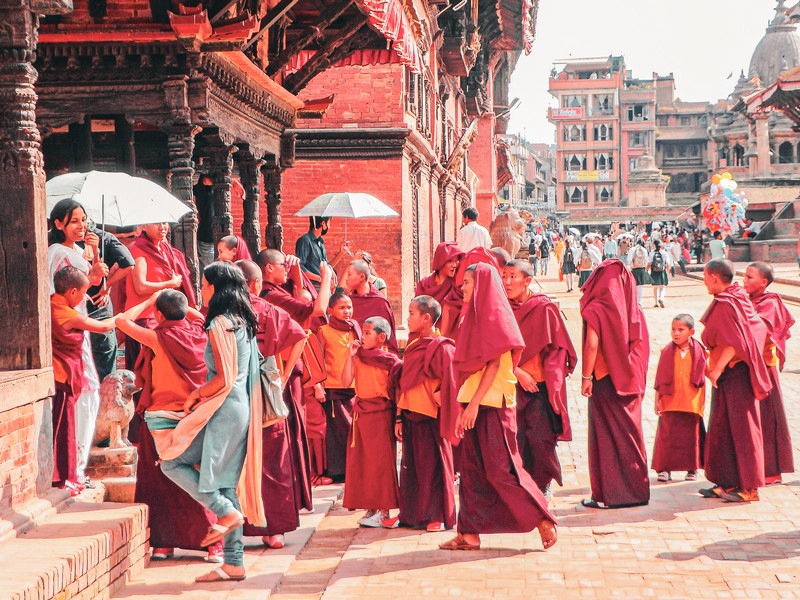
Patan
Patan, Nepal is its own city in Nepal though Kathmandu has spread out so much and Patan is so close that it almost seems like a part of the capital city. Many tourists visit Patan while in Kathmandu and take just a day trip out. The “City of Beauty”, or Lalitpur, as the name is known by locals and written in Sanskrit lives up to the meaning and is a must visit.
…We opted not to have a guide here though there were plenty offering every time we turned around. We took our map and had a look. We saw Krishna Mandir [which was] built in the 17th century by King Siddhi Narsingh Malla. It’s the only temple in Nepal with 21 pinnacles.Built in the Shikhara style of architecture that came from India, the carvings along the edges are notable as they depict the events of Mahabharata and Ramayana.
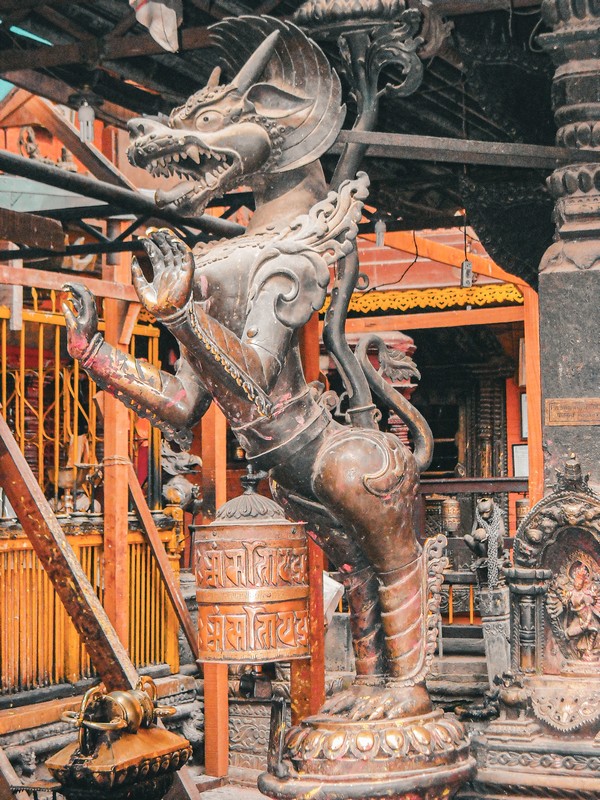
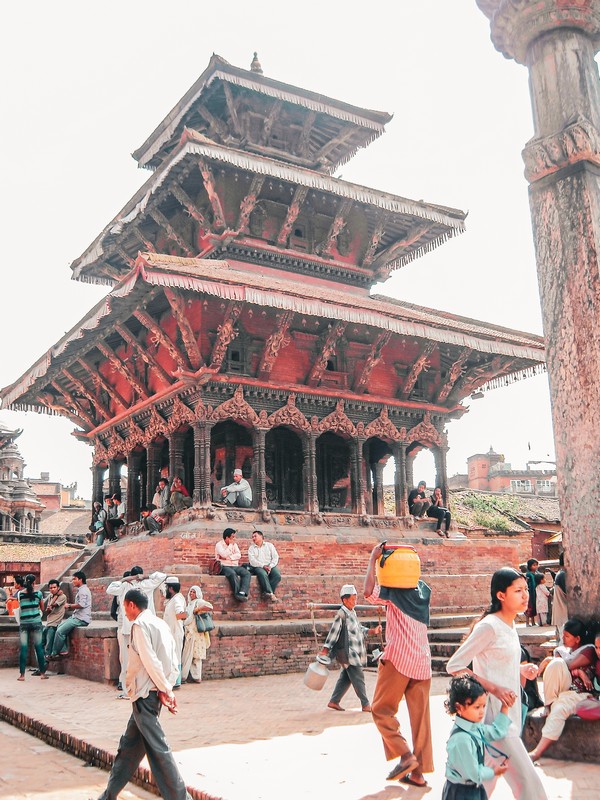
It is said that one night the King saw Lord Krishna and Srimati Radha, his consort, standing in front of the royal palace and so it was ordered that a temple should be built on that very spot. We also visited the Golden Temple, or Hiranya Varna Mahavihar, a three story pagoda of Lord Buddha built in the 12th century is housed inside.
A Nepali man convinced me to buy a sounding bowl used to relive stress. I guess I’ll need it on this trip. After the busy day, we found a rooftop cafe to have dinner in the Durbar Square before heading back to our hotel for the night.
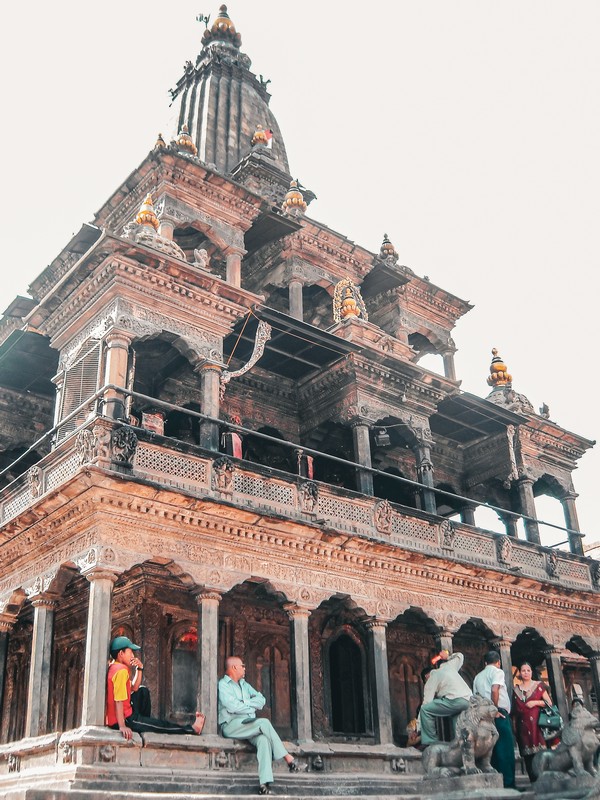
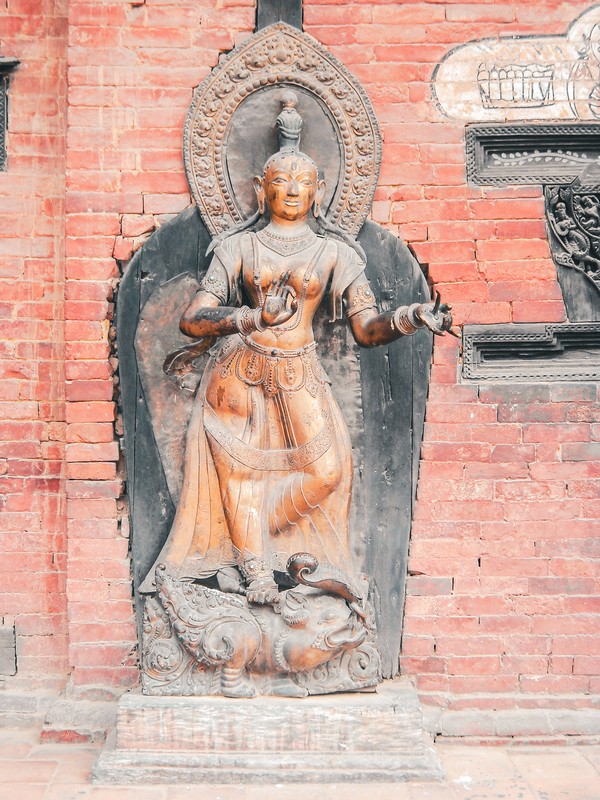
If you’ve never heard of a sounding bowl, or singing bowl, or have and want to partake in the ancient practices in Nepal of using them to refresh your mind and body, then look into joining an experience while you’re in Nepal discover the treatments with the singing bowls. Singing bowl therapy has been around in Northern Asian regions since ancient times and you can partake in the vibrational therapy at Samsara Spa while you visit.
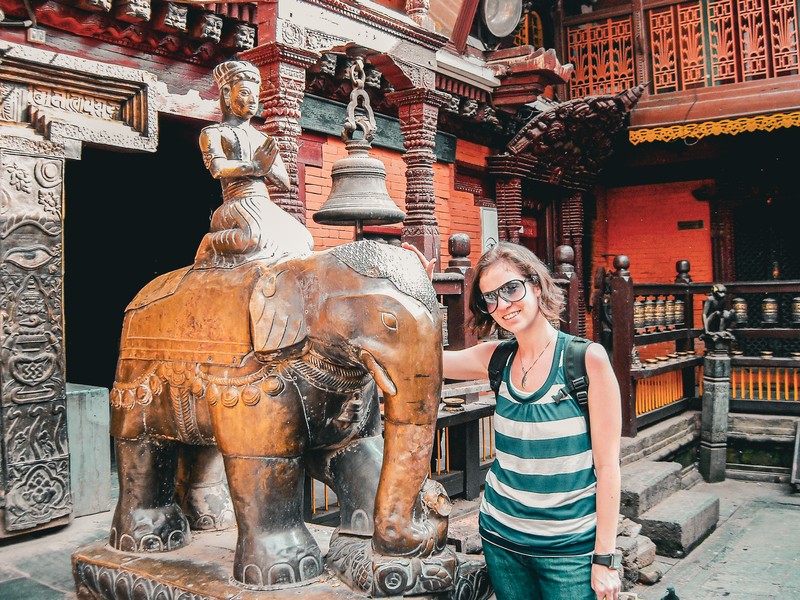
Also to note, the Golden Temple is not actually made of gold but has objects and adornments made of polished brass all around. The moniker probably came from tourists stunned by the shiny beauty. At the entrance to the temple there was once a duel fought between Brahman and Vajracharya Buddhist priest. The priest won when his wife threw her sari over the Brahman’s head and the priest decapitated him. It is said that the severed head is still used in ceremonies today though we couldn’t find any heads anywhere.
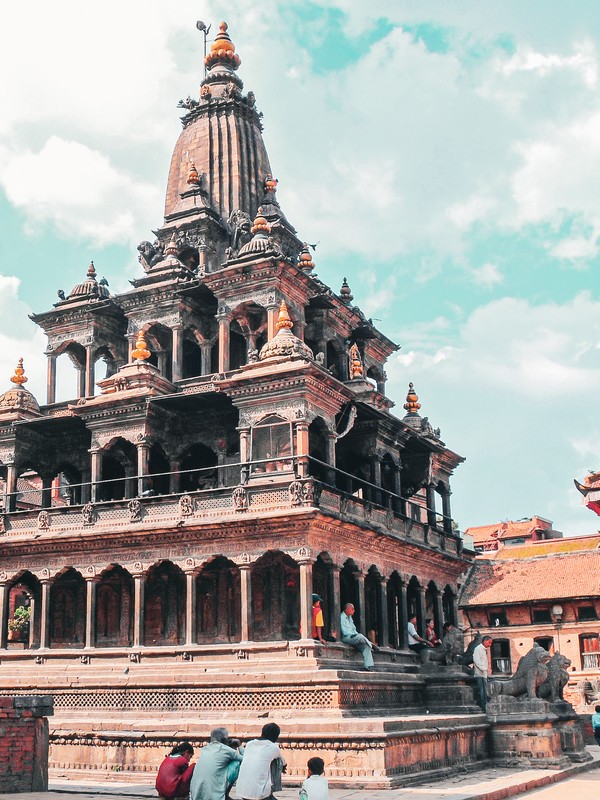
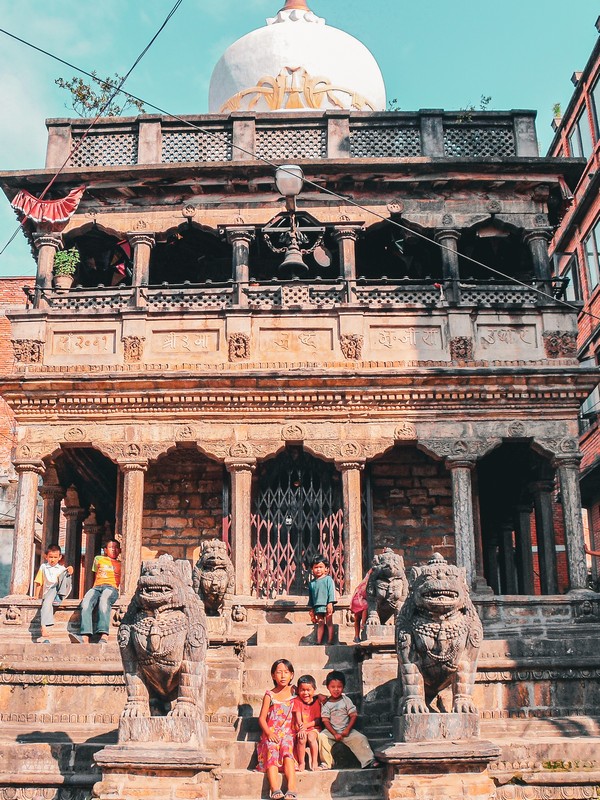
While photographs aren’t permitted inside of the temple itself, visitors are able to take photos of the many artifacts in the courtyard surrounding the temple. We continued our journey around the area taking in all of the new scents and sounds on our first day out in the city. It was intense and amazing and stunning to the eyes.
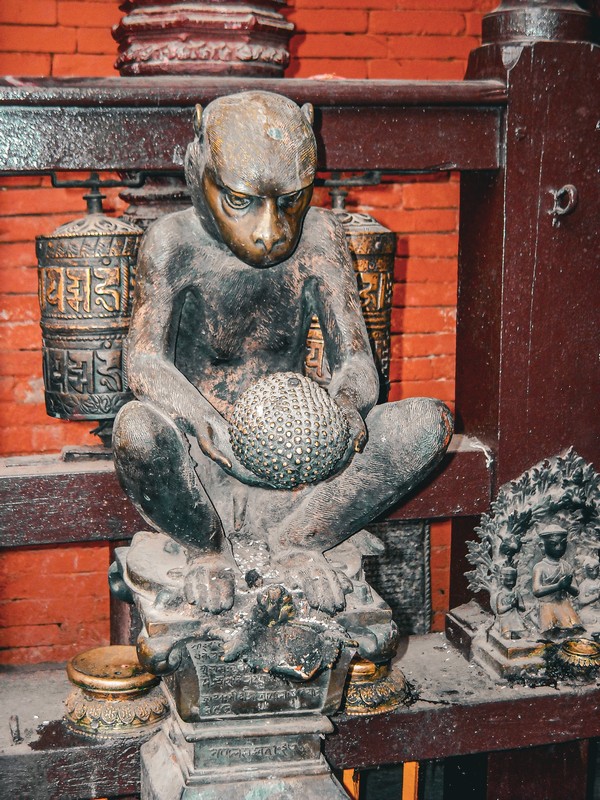
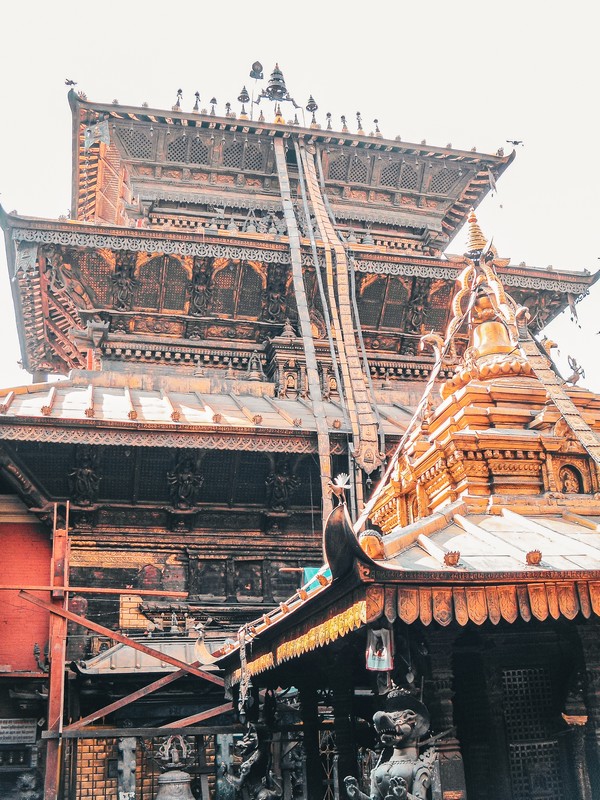
Nagarkot Hill
If you’re an early morning person or are just counting on having jetlag while you’re visiting Kathmandu, then definitely look into visiting Sunrise Hill. Nagarkot is east of Kathmandu and 2000 meters above sea level and is known for having some of the best panoramic views of the rising sun over mountains. Not only can you see Mt. Everest, but you’ll see the nearby steppes on the mountain and watch as the world comes to life again right before your eyes. It’s a must visit… if you can wake up early enough.
- Book Online: You can book a sunrise tour that takes you up to Nagarkot on Klook or on Get Your Guide. Or, sleep in a bit and go up to Nagarkot during the day. You can join that tour on Klook.
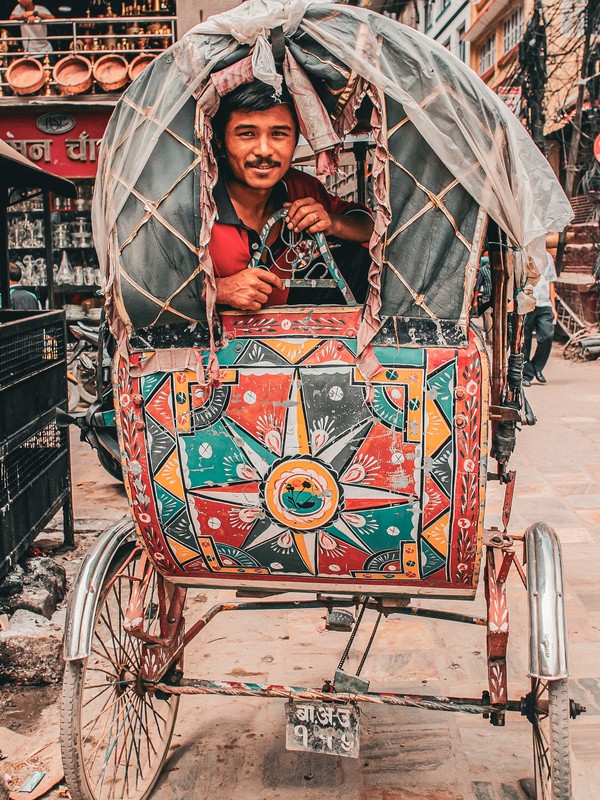
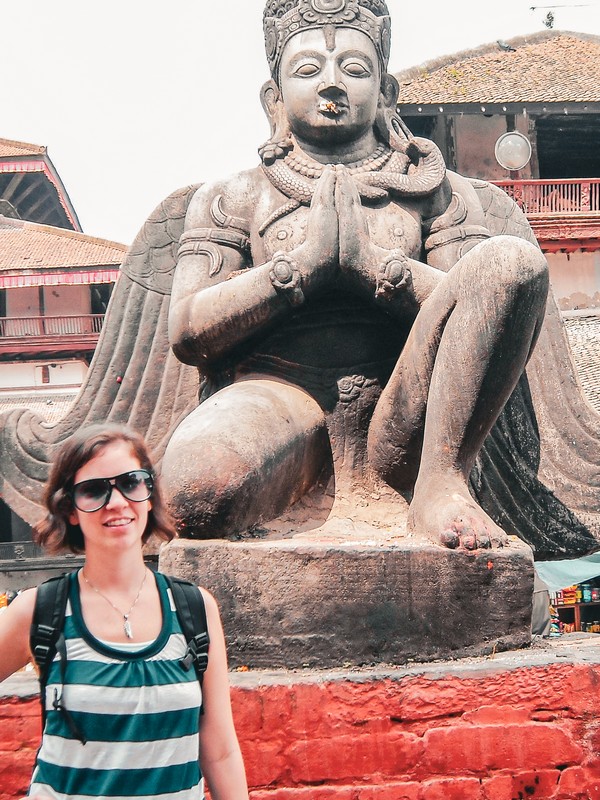
What To Do
There is a ton to do in and around Kathmandu. It is the jumping off point for those looking to get into nature for some adventure travel but there is also plenty to do in the city for rest and relaxation. I usually play it safe when I’m travelling and join for tours for anything adventurous I’m looking to get into because safety is always key but joining cooking and cultural tours is a treat too. There’s really something for everyone and everything offers a look into Nepali culture.
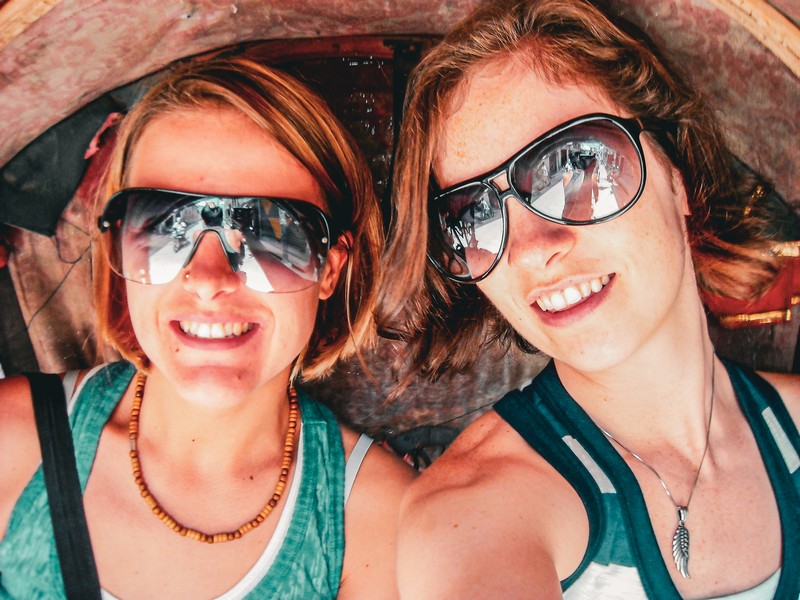
Eat at Bhojan Griha
This unique building that is 150 years old and was built for past royals is now an amazing space to have a five course traditional Newari feast while watching some amazing traditional dancing. Not only is the food amazing and the entertainment faultless, even better is that it’s completely sustainable. They don’t use plastic straws or bottles and the food is 100% organic. Find out more about Bhojan Griha.
Join a Nepali Cooking Class
Cooking is one of the best ways to learn about a culture and while traveling is one of my favorite things to do. Join a tour that will allow you to visit a local market with a guide to source fresh ingredients and then prepare a five course Nepali meal while learning about the spices and cooking techniques. Klook has a great opportunity to have an experience while also benefitting the community. 100% of their profits go to “Journey Nepal” a social welfare organization in the area.
- Book Online: Book a cooking class on Klook or on Get Your Guide.
Rest & Relax In Style
Head to the Mandala Studio Yoga & Spa for dynamic and classical yoga classes as well as numerous spa services. It’s an entire day of pampering and soothing experiences that includes breakfast and lunch. The spa is one of the most highly regarded in the city and they provide professional services that will leave you feeling rejuvenated and ready for the adventure you’re about to take in Nepal. The entire experience includes a yoga session, glow facial, manicure and pedicure, massage, reflexology, body scrub, shirodhara, sauna, and meals. Don’t hesitate to book this when you’re headed to Kathmandu.
- Book Online: Book a class on Klook.
Go Rafting on the Trisuli River
After walking through the hustling bustling city you might want to get out into the nature. Though Nepal has developed quite a bit in the past few decades, it is still 80% rural and natural wonders so don’t hesitate to get out to see the beauty just outside of the city. The river is full of rock formations, flocks of birds and of course some rapids to raft. Even if you’re not a pro, not to worry, there are very adept guides that will get you from the start to finish in very fun fashion. This is also a great way to get from Kathmandu to Pokhara if that’s the route you’re headed on. Definitely book a trip and enjoy the views!
- Book Online: You can book a rafting experience on Klook or on Get Your Guide.
Attend a Classical Performance Under The Full Moon
A music school in Kathmandu named Kirateshwar Sangeet puts together beautiful classical musical performances that are performed each month on the night of the full moon at Kirateshwar Mahadev Temple. The concerts have been performed for over 25 years and the musicians play tablas, flutes, harmoniums and sitars. The concerts are free and usually begin around 5:00pm and last for two hours. It’s truly a special treat to enjoy.
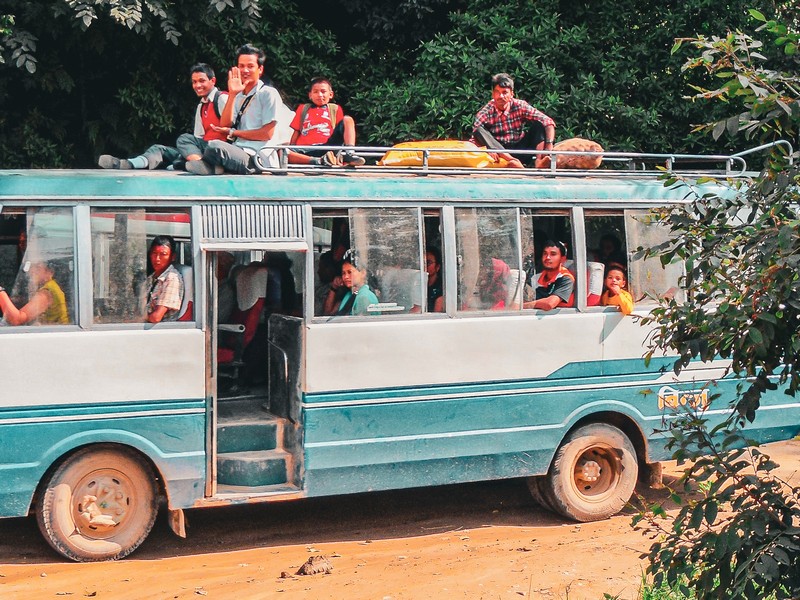
Hike Into the Annapurna Mountain Range
While Everest tops the list for hikes in the area, Annapurna is a close second. Most people will take a twelve day trek that takes them through a very diverse range of scenery and of course affords them gorgeous views. Join a tour to pass by Nadi, Jagat, Dharapani, and Chame villages and see everything from snow-capped mountains to glaciers, pine forests, and ancient monasteries. With a tour you’ll have a guide and a Sherpa to help you along the way and you won’t have to worry about the food and lodging. Take your time and enjoy the views on this amazing adventure.
- Book Online: You can book your trek into the Annapurna Mountain Range on Klook or on Get Your Guide.
Bike the Kakani Mountain
If mountain biking is your jam, then don’t miss an adventure out to Kakani Mountain. You can wind through Shivapuri Nagarjun National Park which is home to the Kathmandu Valley’s water supply and over 170 winged species and rare orchids. The views are just captivating and you’ll see things you wouldn’t be able to see otherwise. Get your bike in gear and stear stear stear.
- Book Online: You can join this experience on Klook.
What To Eat
Nepali food is so so good and throughout this post, I’ve made mention to a few different meals that we had throughout our trip. We were never unsatisfied. Honestly. Here are some meals and eats that you should, but really will mostly likely, have while you’re visiting.
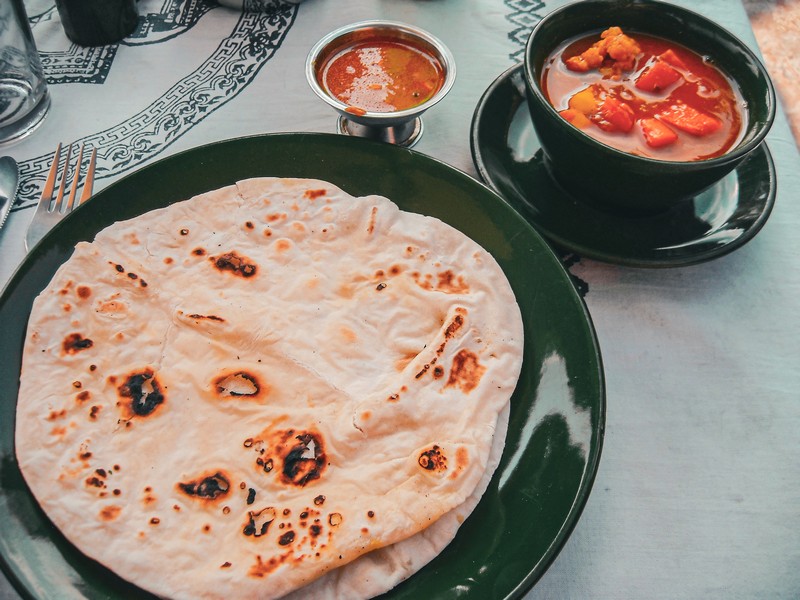
- Momos: Called mandu in Korea and dumplings in the west these pockets stuffed with vegetables, buffalo, or chicken come fried or steamed and you really can’t go wrong with them. In Nepal it is said that the Newar traders brought back the recipe for momo from Tibet. They are truly scrumptious.
- Choila: For something a bit heavier, try this spicy grilled buffalo meat dish which goes down really well with a beer for dinner.
- Thali & Dal Bhat: Thali is a staple meal in Nepal that is served on a metal plate and is found pretty much everywhere you go. The meal is served with dal bhat (rice & lentils), masu (meat), tarkari (a vegetable curry), saag (leafy greens), and achar (pickle). It’s often all you can eat so just keep filling up until you’re full.
- Thukpa & Thenthuk: If you like soups, don’t leave without trying these. They are a mix of meat, noodles, and vegetables that is delicious and filling.
Get ready for an epic adventure in Nepal. You can easily fill five days in Kathmandu and more probably. Here’s a good place to start.
Did you like this post? Pin IT!
